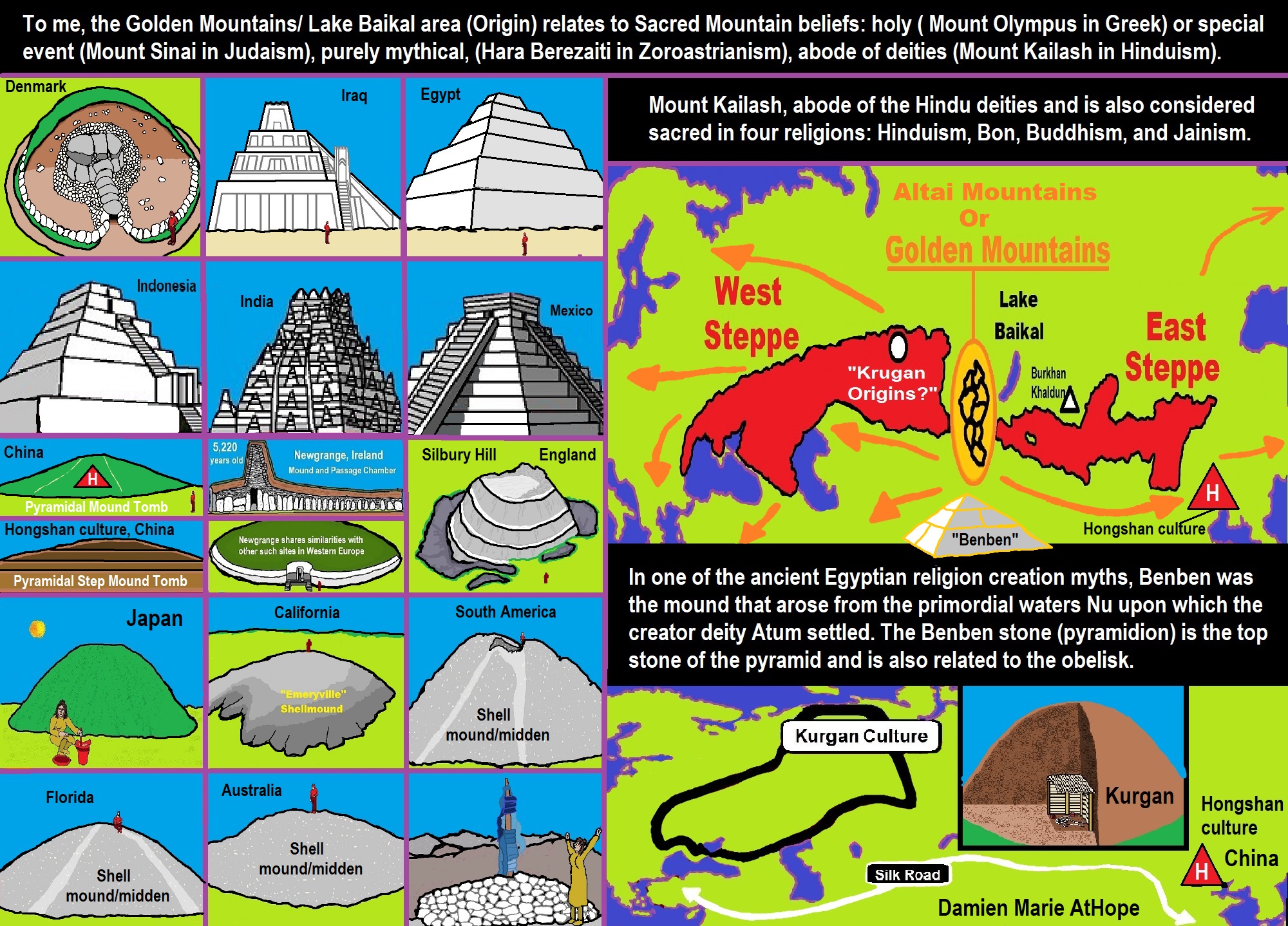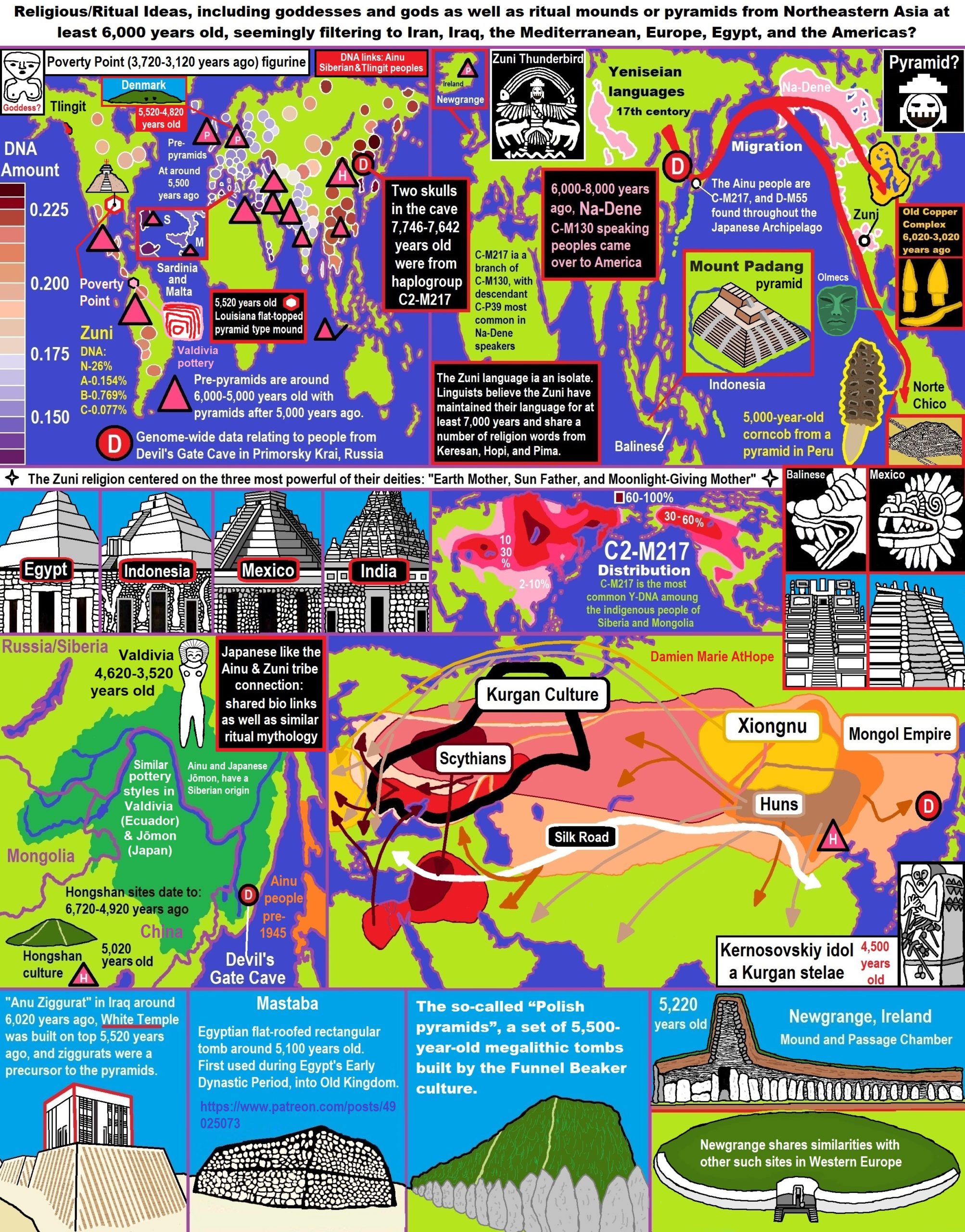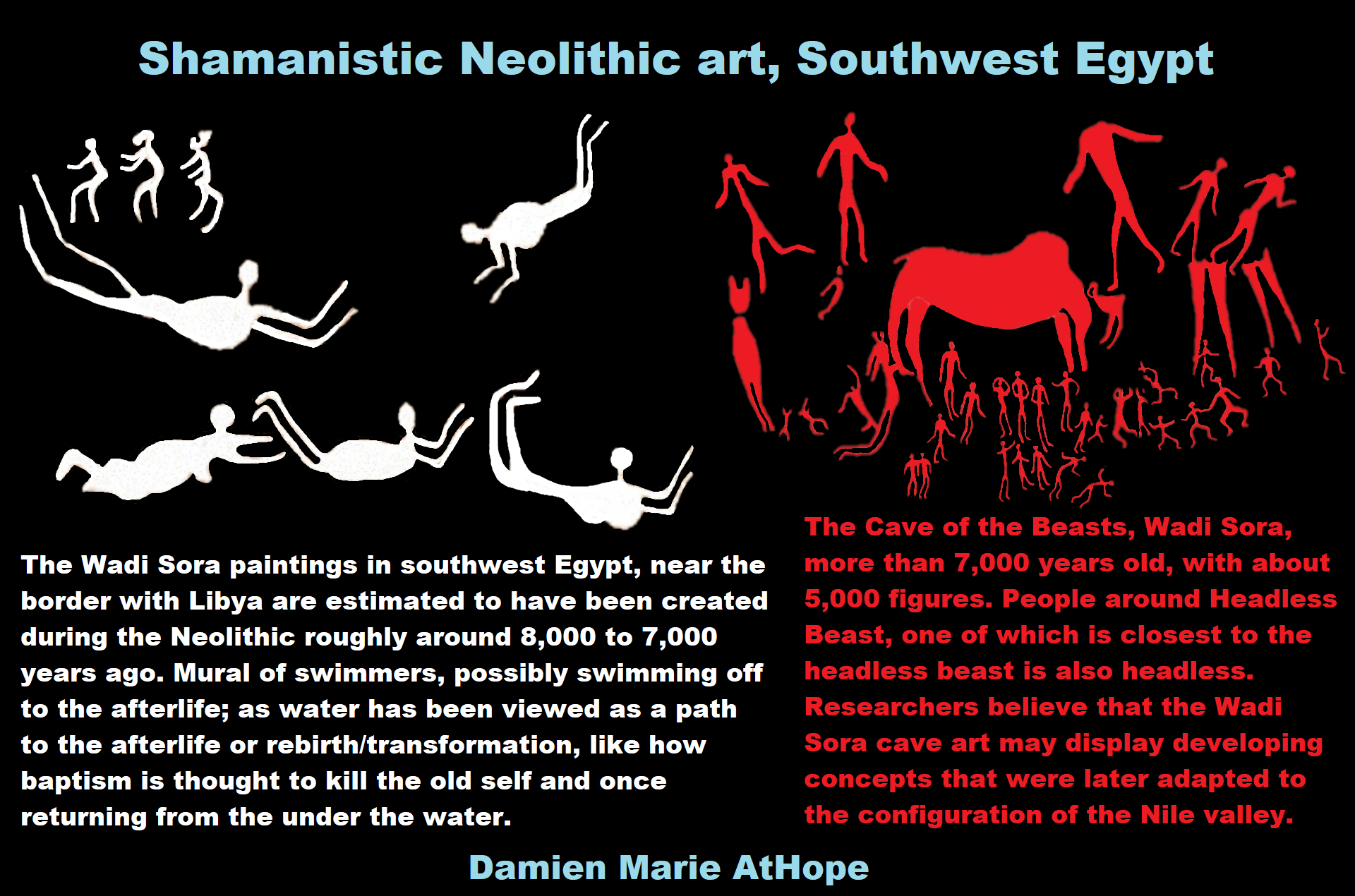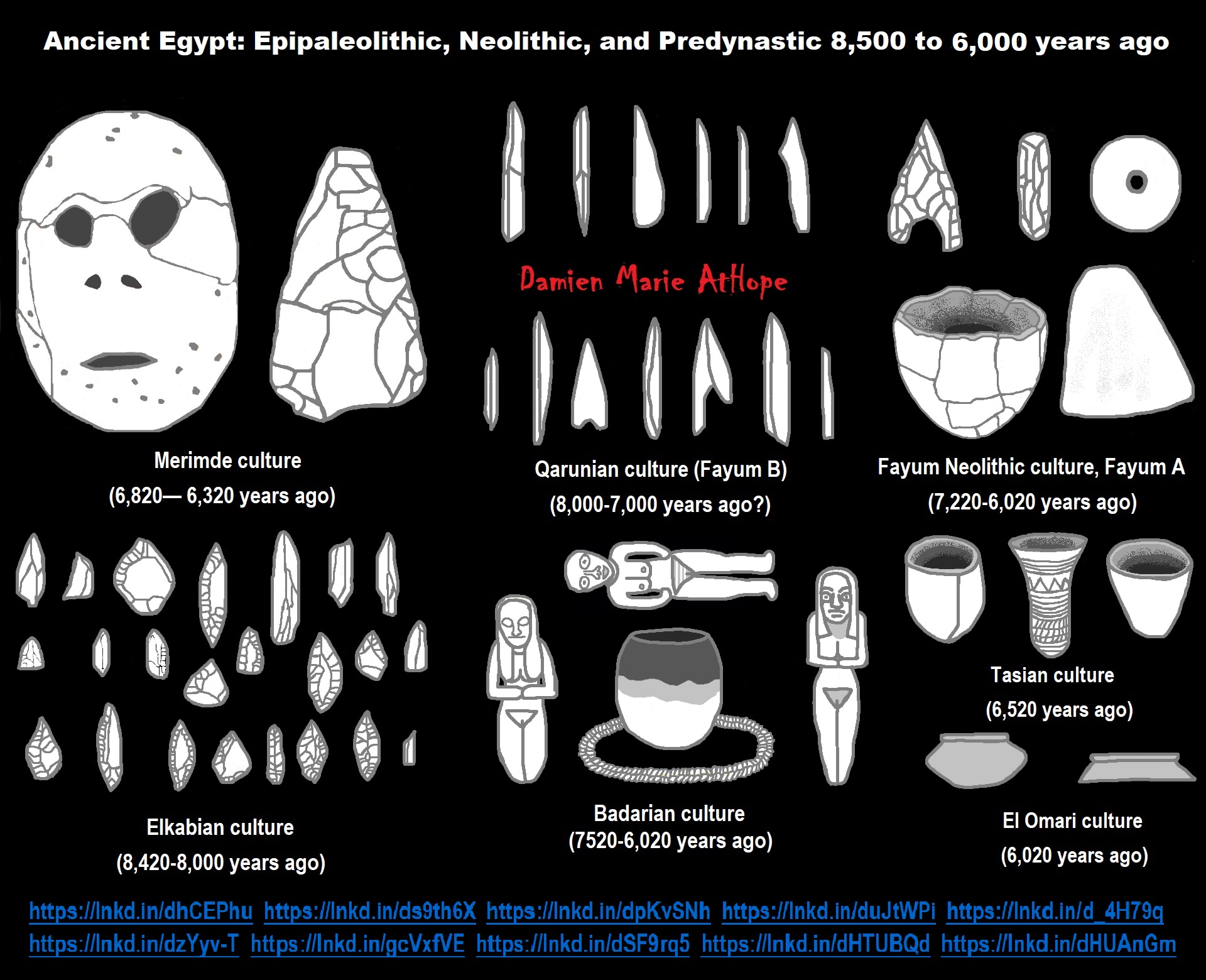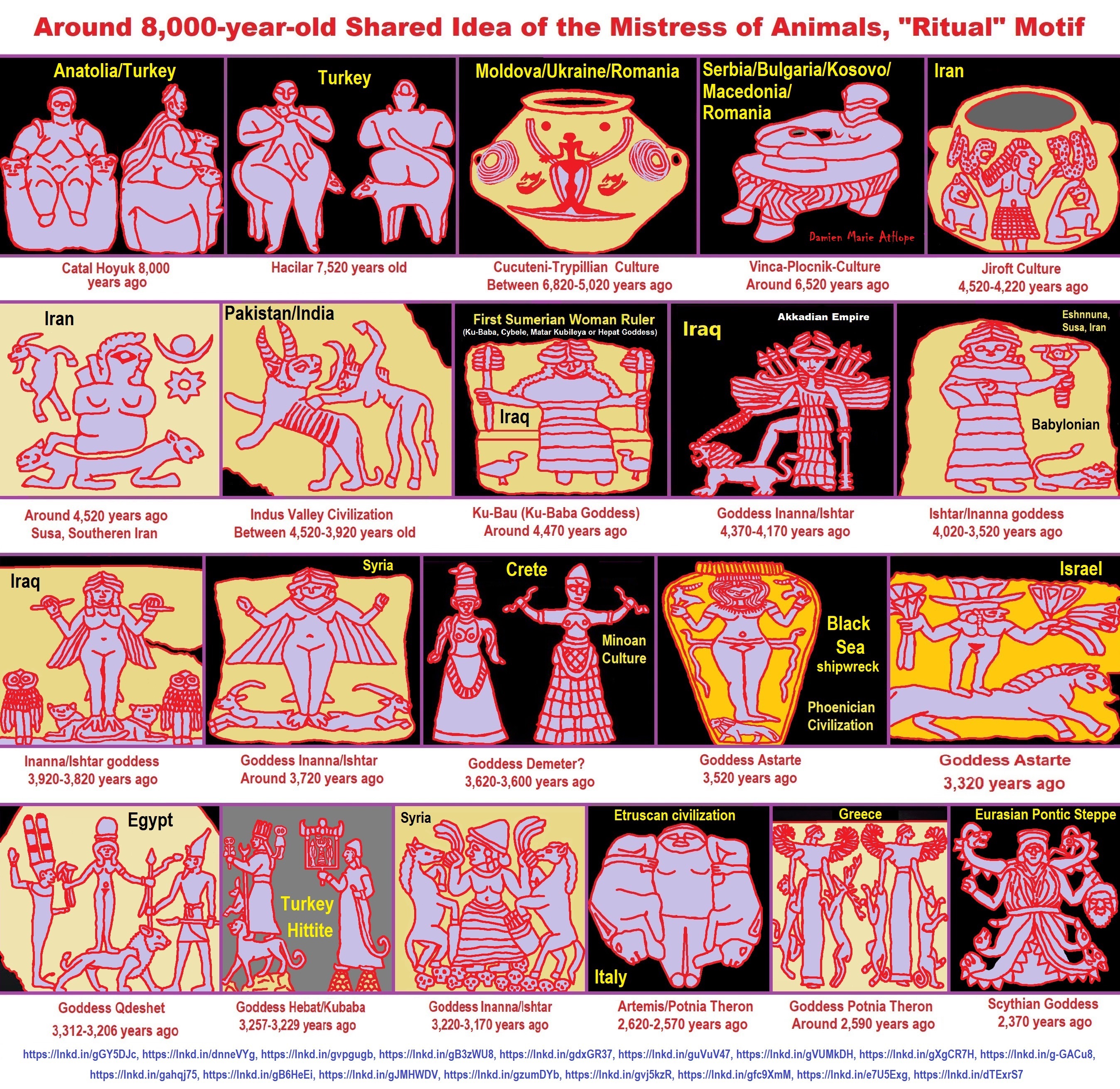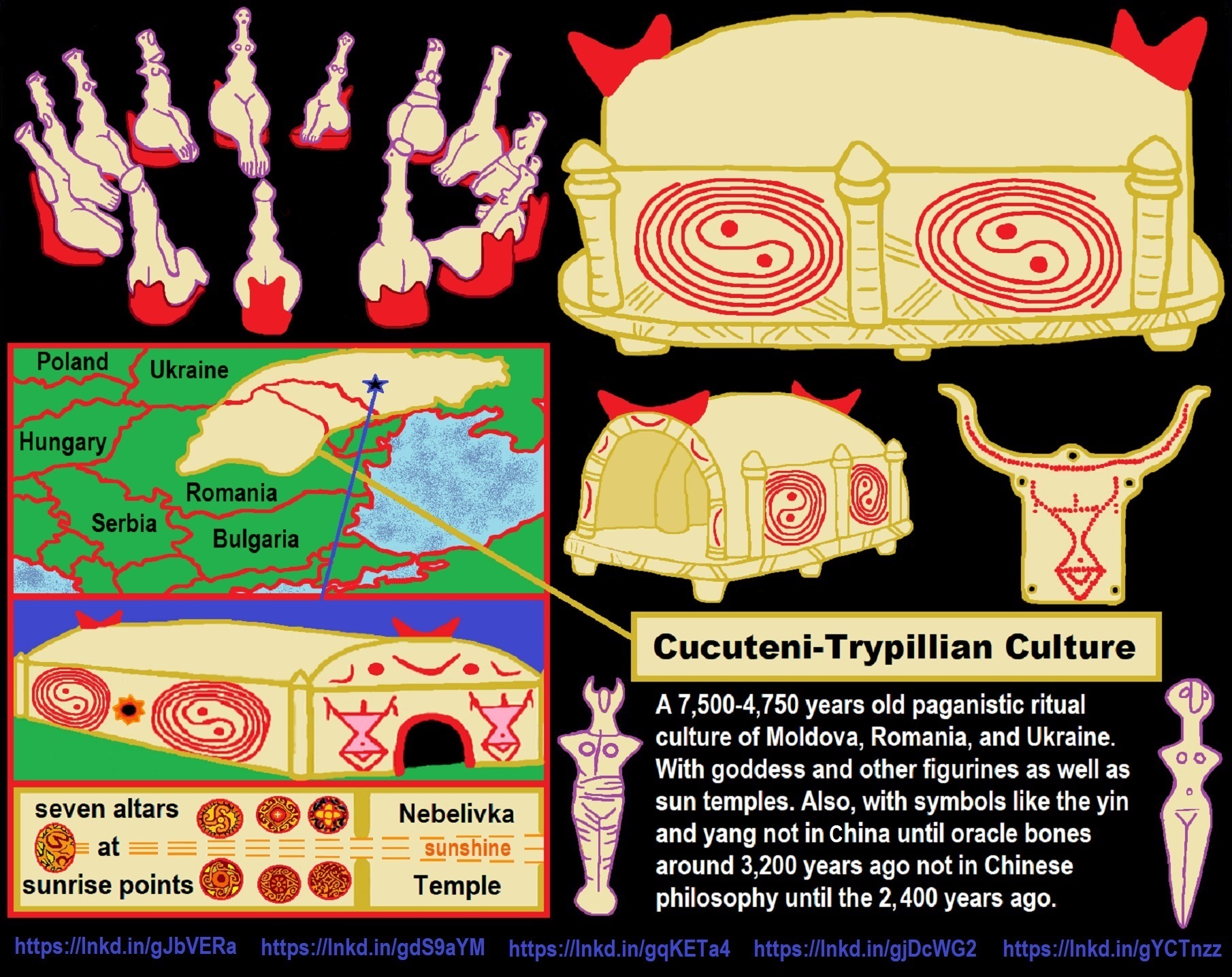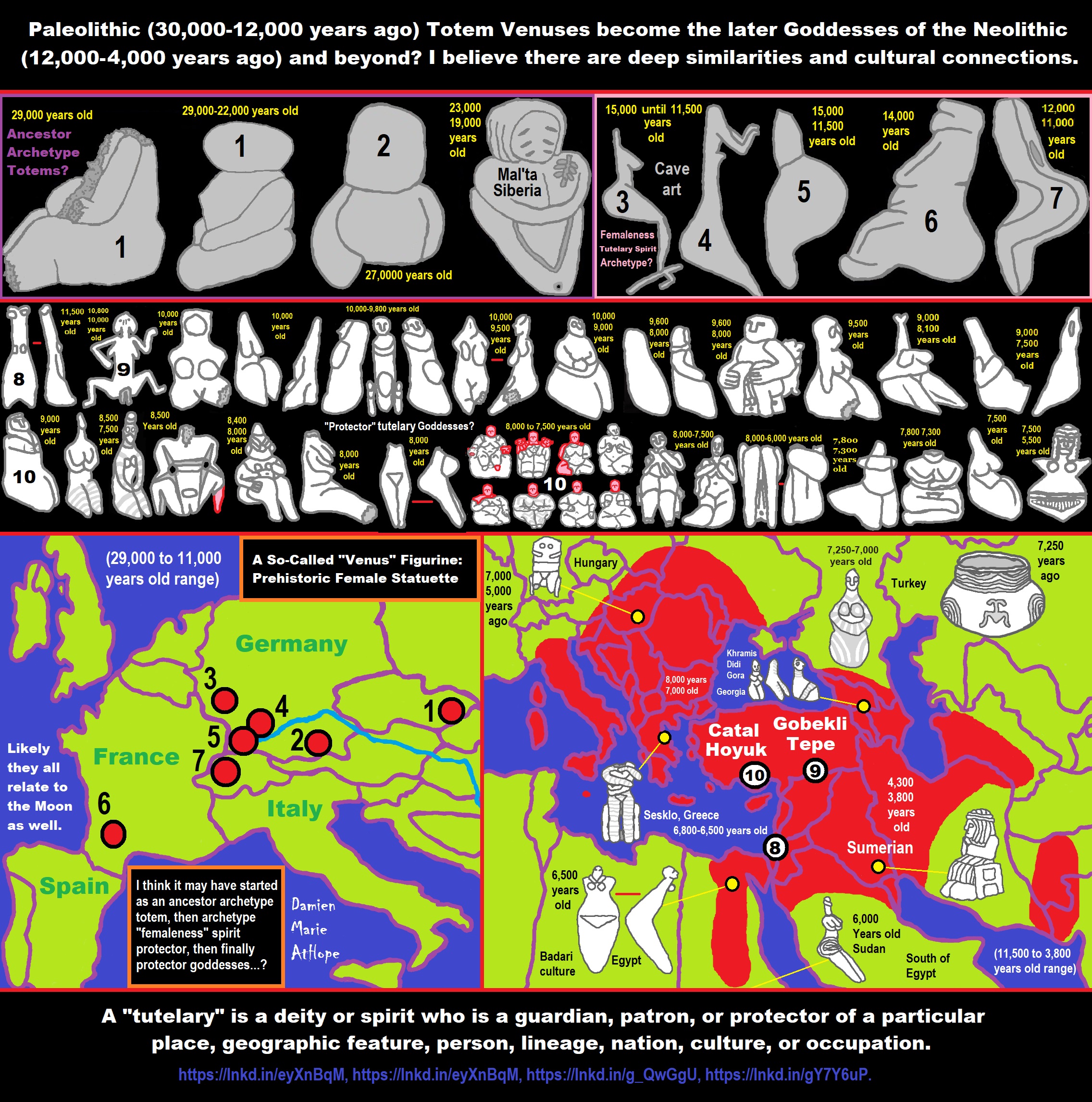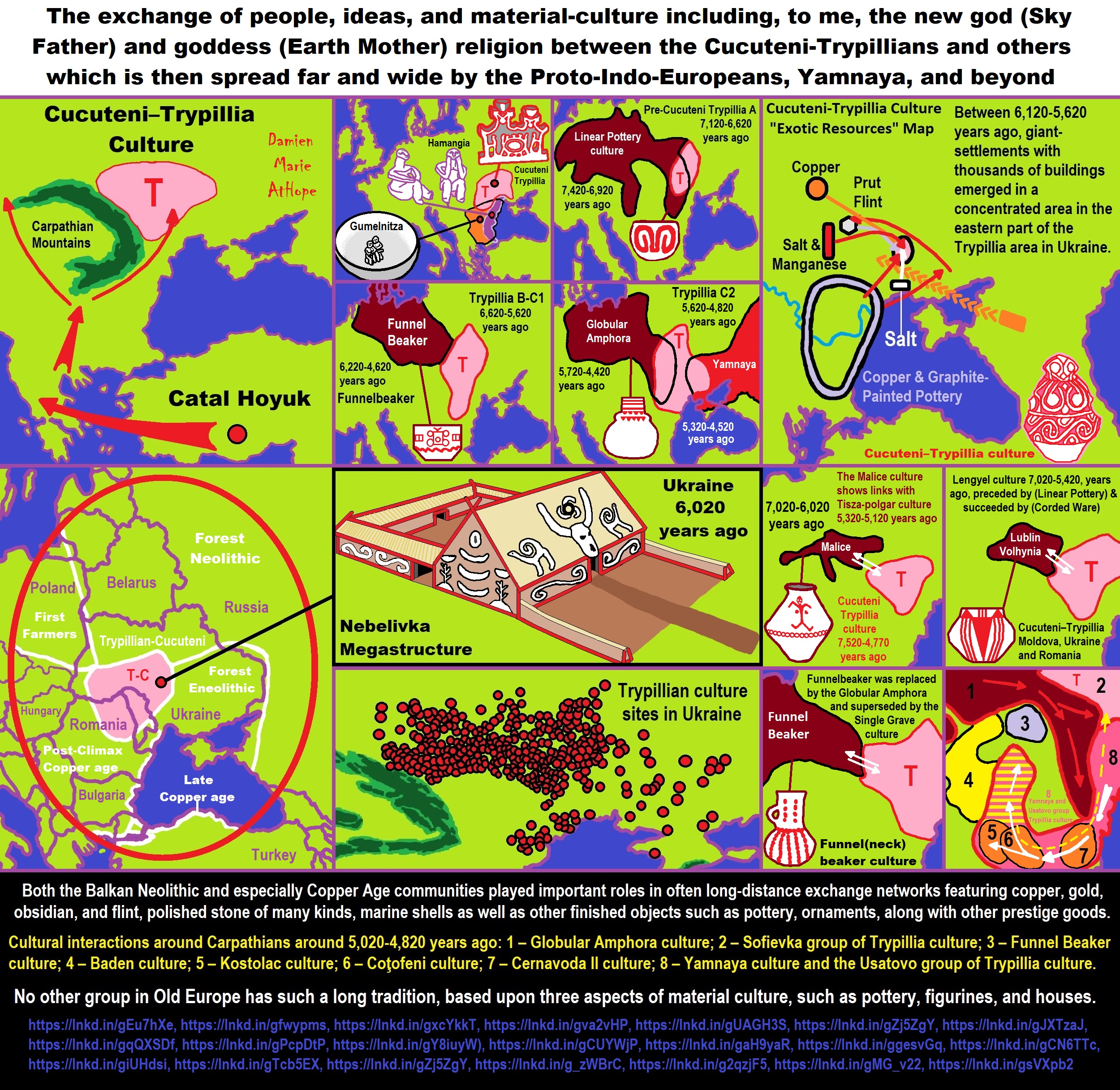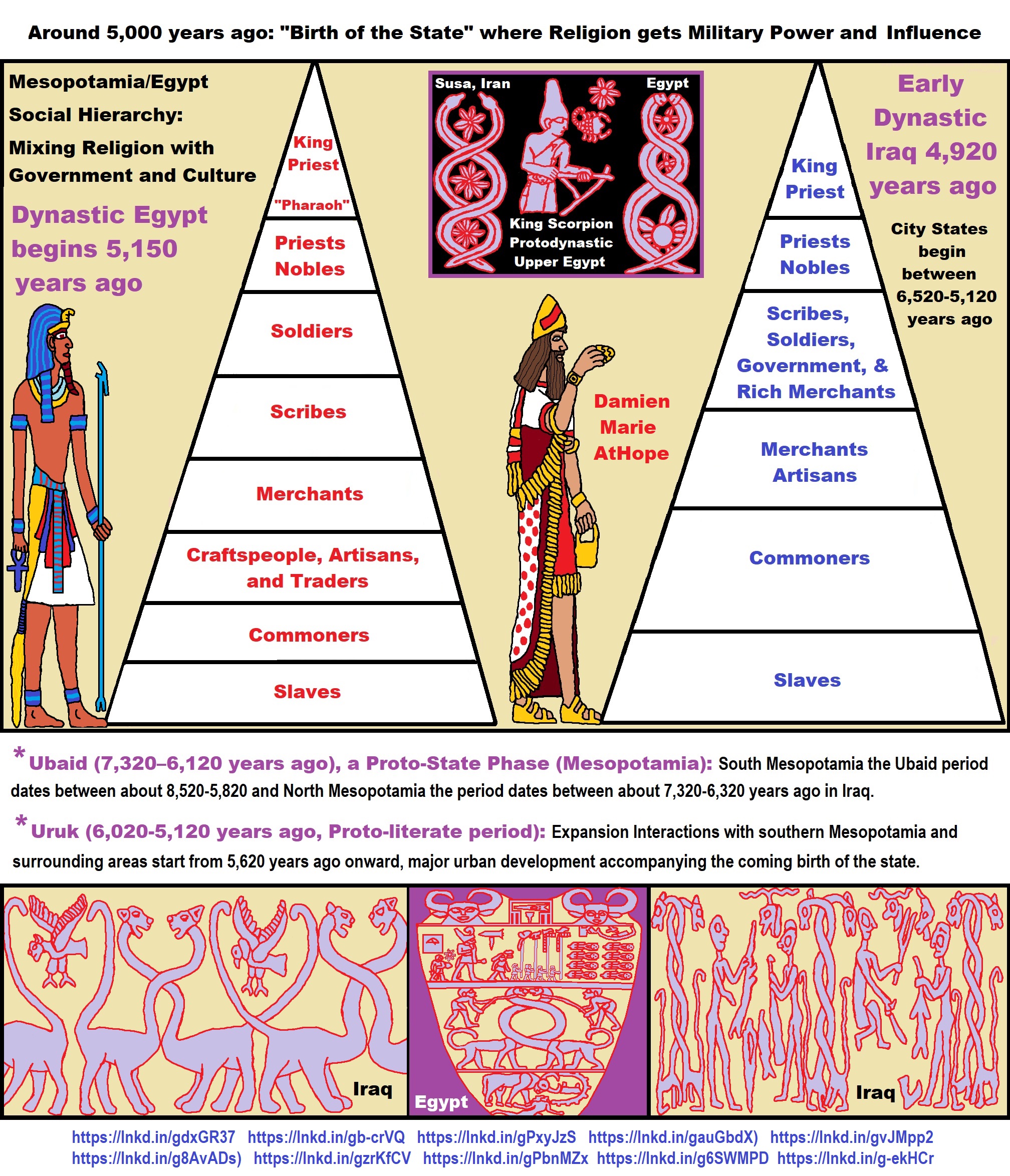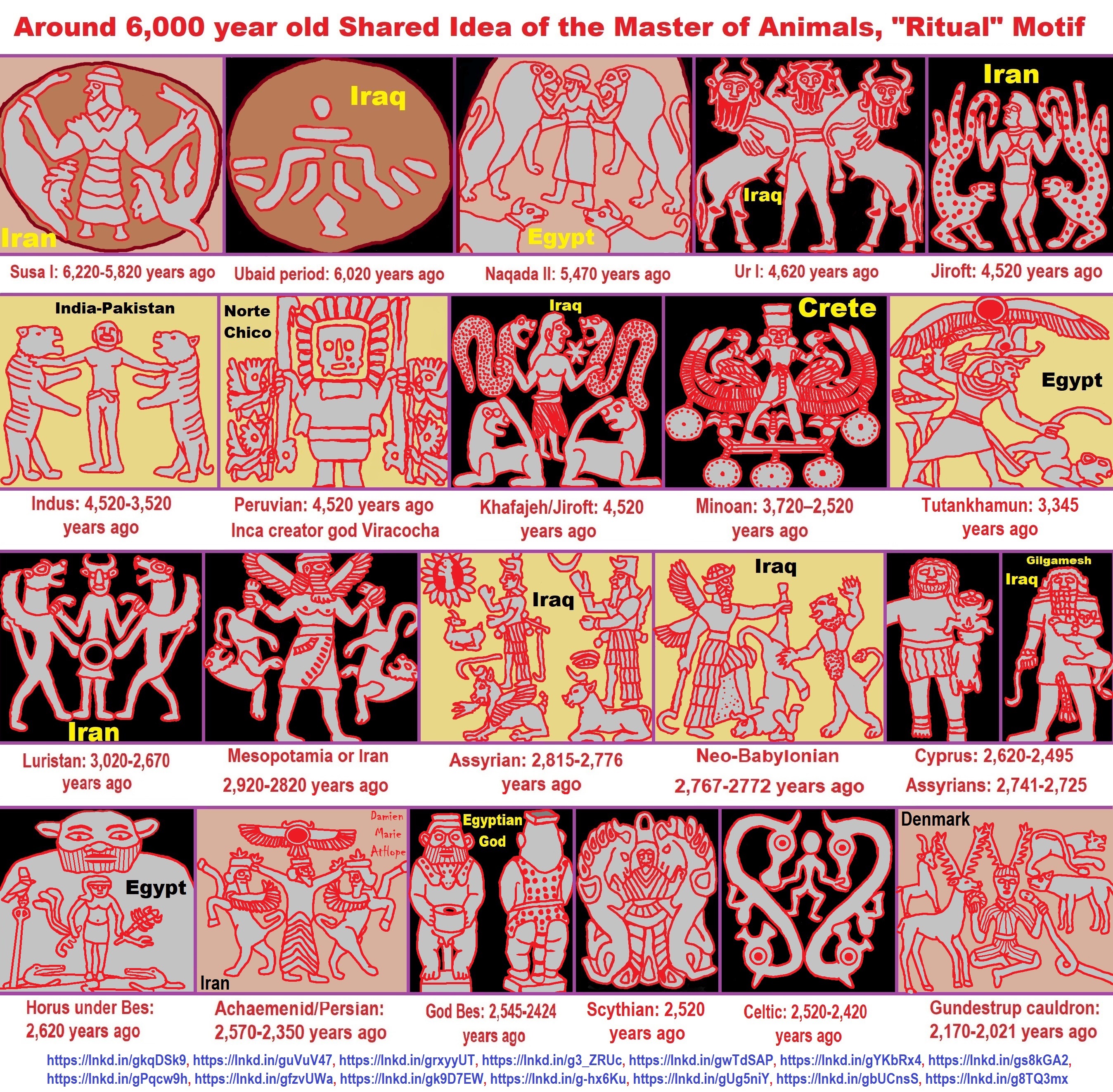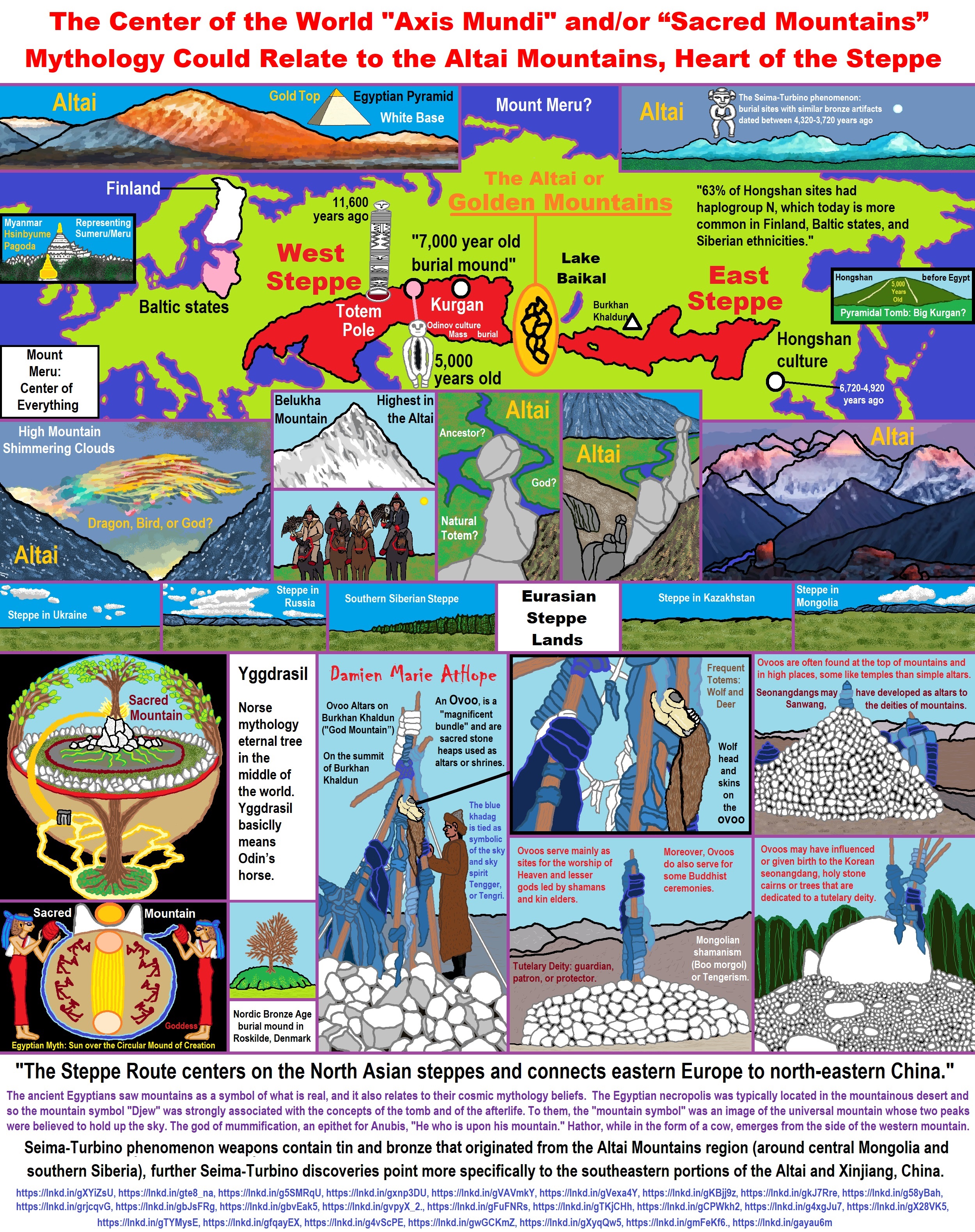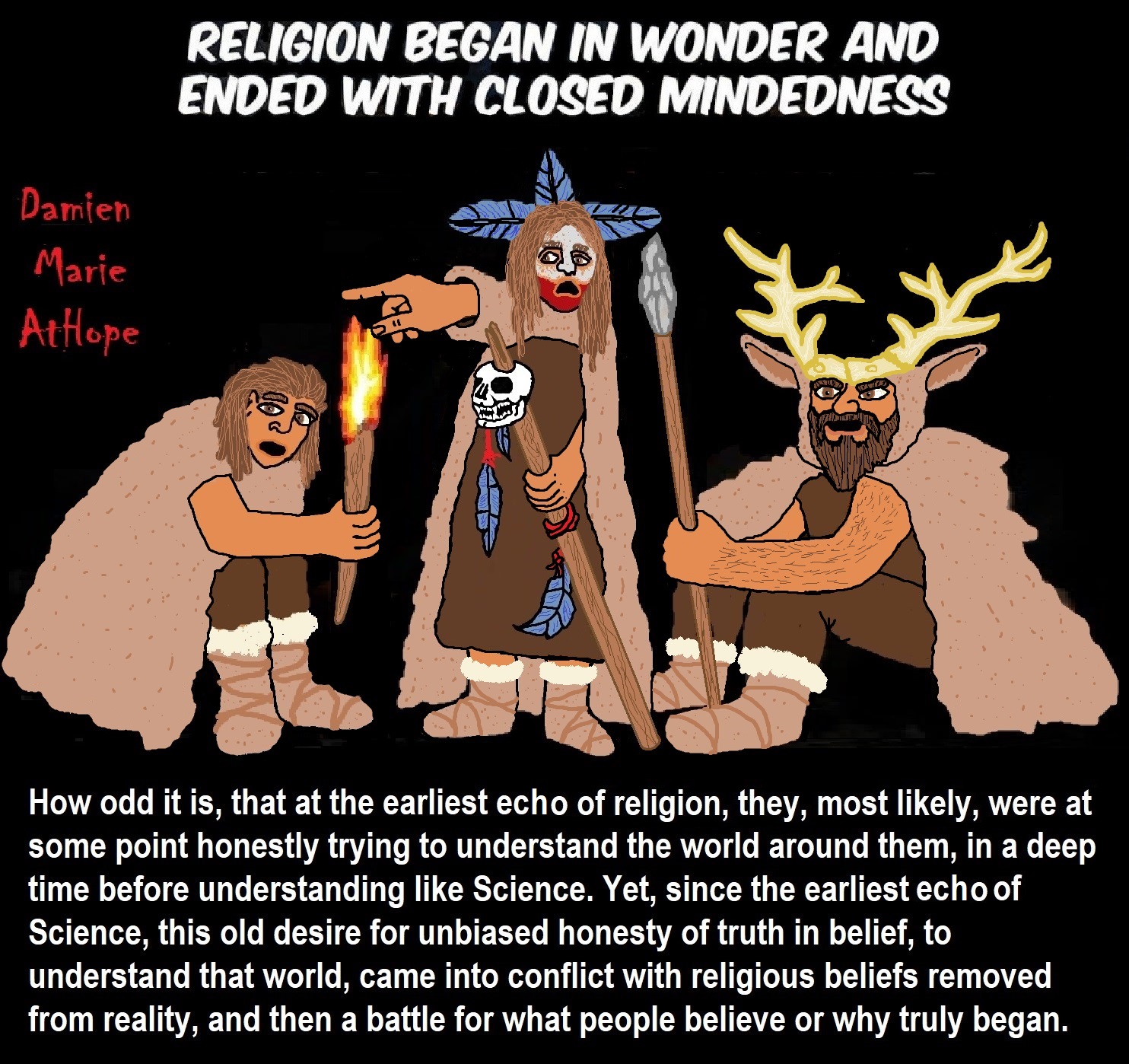
Guanches People
“The Guanches were the aboriginal inhabitants of the Canary Islands. In 2017, the first genome-wide data from the Guanches confirmed a North African origin and that they were genetically most similar to ancient North African Berber peoples of the nearby North African mainland. It is believed that they may have arrived on the archipelago some time in the first millennium BCE or between around 3,020-2,020 years ago. The native term guanchinet literally translated means “person of Tenerife” (from Guan = person and Chinet = Tenerife). It was modified, according to Juan Núñez de la Peña, by the Castilians into “Guanches”. Though etymologically being an ancient, Tenerife-specific, term, the word Guanche is now mostly used to refer to the pre-Hispanic aboriginal inhabitants of the entire archipelago.” ref
Guanches Genetics
“Genetic evidence shows that northern African peoples made a significant contribution to the aboriginal population of the Canaries following desertification of the Sahara at some point after 6000 BCE or after around 8,020 years ago. Linguistic evidence suggests ties between the Guanche language and the Berber languages of North Africa, particularly when comparing numeral systems. Research into the genetics of the Guanche population has led to the conclusion that they share an ancestry with Berber peoples.” ref
“Maca-Meyer et al. 2003 extracted 71 samples of mtDNA from Guanches buried at numerous Canary Islands c. 1000 AD. The examined Guanches were found to have the closest genetic affinities to modern Moroccan Berbers, Canary Islanders, and Spaniards. They carried a significantly high amount of the maternal haplogroup U6b1. U6b1 is found at very low frequencies in North Africa today, and it was suggested that later developments have significantly altered the Berber gene pool. The authors of the study suggested that the Guanches were descended from migrants from North Africa related to the Berbers, and that the Guanches contributed c. 42%–73% to the maternal gene pool of modern Canary Islanders.” ref
“Fregel et al. 2009a extracted 30 samples of Y-DNA from Guanches of the Canary Islands. These belonged to the paternal haplogroups E1a*, (3.33%), E1b1b1a* (23.33%), E1b1b1b* (26.67%), I* (6.67%), J1* (16.67%), K*, P* (3.33%), and R1b1b2 (10.00%). E1a*, E1b1b1a*, and E1b1b1b* are common lineages among Berbers, and their high frequency among the Guanches were considered evidence that they were migrants from North Africa. R1b1b2 and I* are very common in lineages in Europe, and their moderate frequency among the examined Guanche males was suggested to have been a result of prehistoric gene flow from Europe into the region across the Mediterranean. It was found that Guanche males contributed less to the gene pool of modern Canary Islanders than Guanche females. Haplogroups typical among the Guanche have been found at high frequencies in Latin America, suggesting that descendants of the Guanche played an active role in the Spanish colonization of the Americas.” ref
“Fregel et al. 2009b extracted the mtDNA of 30 Guanches from La Palma, (Benahoaritas). 93% of their mtDNA haplogroups were found to be of West Eurasian origin, while 7% were of sub-Saharan African origin. About 15% of their West Eurasian maternal lineages are specific to Europe and the Near East rather than North Africa, suggesting that the Benahoaritas traced partial descent from either of these regions. The examined Benahoaritas were found to have high frequencies of the maternal haplogroups U6b1 and H1-16260. U6b1 has not been found in North Africa, while H1-16260 is “extremely rare”. The results suggested that the North African population from whom the Benahoaritas and other Guanches descended have been largely replaced by subsequent migrations.” ref
“Pereira et al. 2010 studies the origins of the maternal haplogroup U6, which is characteristic of Guanches. It was suggested that the U6 had been brought to North Africa by Cro-Magnon-like humans from the Near East during the Upper Paleolithic, who were probably responsible for the formation of the Iberomaurusian culture.[36] It was also suggested that the maternal haplogroup H1, also frequent among Guanches, had been brought to North Africa during the Holocene by migrants from Iberia, who may have participated in the formation of the Capsian culture. In a further study, Secher et al. 2014 suggested that U6 had been brought to the Levant from Central Europe in the Upper Paleolithic by people of the Aurignacian culture, forming the Levantine Aurignacian (c. 33,000 BCE), whose descendants had then further spread U6 as part of a remigration into Africa. U6b1a was suggested to have been brought to the Canary Islands during the initial wave of settlement by Guanches, while U6c1 was suggested to have been brought in a second wave.” ref
“Fregel et al. 2015 examined the mtDNA of Guanches of La Gomera (Gomeros). 65% of the examined Gomero swere found to be carriers of the maternal haplogroup U6b1a. The Gomero appeared to be descended from the earliest wave of settlers to the Canary Islands. The maternal haplogroups T2c1 and U6c1 may have been introduced in a second wave of colonization affecting the other islands. It was noted that 44% of modern La Gomerans carry U6b1a. It was determined that La Gomerans have the highest amount of Guanche ancestry among modern Canary Islanders.” ref
“Ordóñez et al. 2017 examined the remains of a large number of Guanches of El Hierro (Bimbache) buried at Punta Azul, El Hierro c. 1015–1200 AD. The 16 samples of Y-DNA extracted belonged to the paternal haplogroups E1a (1 sample), E1b1b1a1 (7 samples), and R1b1a2 (7 samples). All the extracted samples of mtDNA belonged to the maternal haplogroup H1-1626. The Bimbache were identified as descendants of the first wave of Guanche settlers on the Canary Islands, as they lacked the paternal and maternal lineages identified with the hypothetical second wave.” ref
“Rodríguez-Varela et al. 2017 examined the atDNA of 11 Guanches buried at Grand Canaria and Tenerife. The 3 samples of Y-DNA extracted all belonged to the paternal haplogroup E1b1b1b1a1 (E-M183), while the 11 samples of mtDNA extracted belonged to the maternal haplogroups H1cf, H2a, L3b1a (3 samples), T2c12, U6b1a (3 samples), J1c3, and U6b. It was determined that the examined Guanches were genetically similar between the 7th and 11th centuries AD, and that they displayed the closest genetic affinity to modern North Africans. The evidence supported the notion that the Guanches were descended from a Berber-like population who had migrated from North Africa. Among modern populations, Guanches were also found to be genetically similar to modern Sardinians. Some models found the Guanche to be more closely related to modern Sardinians than modern North Africans. They were determined to be carriers of Early European Farmer (EEF) ancestry, which probably spread into North Africa from Iberia during the Neolithic, or perhaps also later. One Guanche was also found to have ancestry related to European hunter-gathers, providing further evidence of prehistoric gene flow from Europe. It was estimated that modern Canary Islanders derive 16%–31% of their atDNA from the Guanches.” ref
“Fregel et al. 2018 examined remains at the Late Neolithic site of Kelif el Boroud, Morocco (c. 3780–3650 BCE or 5,780-5,650 years ago). The Kelif el Boroud people were modeled as being equally descended from people buried at the Neolithic sites of Ifri N’Ammar, Morocco (c. 5325–4786 BCE or 7,345-6,806 years ago) and the Cave of El Toro, Spain (5280–4750 BCE or 7,300-6770 years ago). The Kelif el Boroud were thus determined to have carried 50% EEF ancestry, which may have spread with the Cardial Ware culture from Iberia to North Africa during the Neolithic. After the Kelif el Boroud people, additional European ancestry may have been brought to the region from Iberia by people of the Bell Beaker culture. Guanches were found to the genetically very similar to the Kelif el Boroud people.” ref
“Fregel et al. 2019 examined the mtDNA of 48 Guanches buried on all the islands of the Canaries. They were found to be carrying maternal lineages characteristic of both North Africa, Europe, and the Near East, with Eurasian lineages centered around the Mediterannean being the most common. It was suggested that some of these Eurasian haplogroups had arrived in the region through Chalcolithic and Bronze Age migrations from Europe. Genetic diversity was found to be the highest at Gran Canaria, Tenerife, and La Palma, while Lanzarote, Fuerteventura, and particularly La Gomera and El Hierro had low diversity. Significant genetic differences were detected between Guanches of western and eastern islands, which supported the notion that Guanches were descended from two distinct migration waves. It was considered significant that 40% of all examined Guanches so far belonged to the maternal haplogroup H.” ref
Guanche language
“Guanche is an extinct language that was spoken by the Guanches of the Canary Islands until the 16th or 17th century. It died out after the conquest of the Canary Islands as the Guanche ethnic group was assimilated into the dominant Spanish culture. The Guanche language is known today through sentences and individual words that were recorded by early geographers, as well as through several place-names and some Guanche words that were retained in the Canary Islanders’ Spanish.” ref
“The native Guanche language is now only known through a few sentences and individual words, supplemented by several placenames. Many modern linguists propose that it belongs to the Berber branch of the Afroasiatic languages. However, while there are recognizable Berber words (particularly with regards to agriculture) within the Guanche language, no Berber grammatical inflections have been identified; there is a large stock of vocabulary that does not bear any resemblance to Berber whatsoever.” ref
“Guanche has not been classified with any certainty. Many linguists propose that Guanche was likely a Berber language, or at least related to the Berber languages. However, recognizable Berber words are primarily agricultural or livestock vocabulary, whereas no Berber grammatical inflections have been identified, and there is a large stock of vocabulary that does not bear any resemblance to Berber whatsoever. It may be that Guanche had a stratum of Berber vocabulary but was otherwise unrelated to Berber. Other strong similarities to the Berber languages are reflected in their counting system.” ref
“The name Guanche originally referred to a “man from Tenerife“, and only later did it come to refer to all native inhabitants of the Canary Islands. Different dialects of the language were spoken across the archipelago. Archaeological finds on the Canaries include both Libyco-Berber and Punic inscriptions in rock carvings, although early accounts stated the Guanches themselves did not possess a system of writing.” ref
“The first reliable account of the Guanche language was provided by the Genovese explorer Nicoloso da Recco in 1341, with a list of the numbers 1–16, possibly from Fuerteventura. Recco’s account reveals a base-10 counting system with strong similarities to Berber numbers. Silbo, originally a whistled form of Guanche speech used for communicating over long distances, was used on La Gomera, El Hierro, Tenerife, and Gran Canaria. As the Guanche language became extinct, a Spanish version of Silbo was adopted by some inhabitants of the Canary Islands.” ref
Religion and mythology
See also: Traditional Berber religion
“Little is known of the religion of the Guanches. There was a general belief in a supreme being, called Achamán in Tenerife, Acoran in Gran Canaria, Eraoranhan in Hierro, and Abora in La Palma. The women of Hierro worshipped a goddess called Moneiba. According to tradition, the male and female gods lived in mountains, from which they descended to hear the prayers of the people. On other islands, the natives venerated the sun, moon, earth, and stars. A belief in an evil spirit was general. The demon of Tenerife was called Guayota and lived at the peak of Teide volcano, which was the hell called Echeyde; in Tenerife and Gran Canaria, the minor demons took the form of wild black woolly dogs called Jucanchas in the first and Tibicenas in the latter, which lived in deep caves of the mountains, emerging at night to attack livestock and human beings.” ref
“In Tenerife, Magec (god of the Sun) and Chaxiraxi (the goddess mother) were also worshipped. In times of drought, the Guanches drove their flocks to consecrated grounds, where the lambs were separated from their mothers in the belief that their plaintive bleating would melt the heart of the Great Spirit. During the religious feasts, hostilities were held in abeyance, from war to personal quarrels. Idols have been found in the islands, including the Idol of Tara (Museo Canario, Las Palmas de Gran Canaria) and the Guatimac (Museum Archaeological of Puerto de la Cruz in Tenerife). But many more figures have been found in the rest of the archipelago.” ref
“Most researchers agree that the Guanches performed their worship in the open, under sacred trees such as pine or drago, or near sacred mountains such as Mount Teide, which was believed to be the abode of the devil Guayota. Mount Teide was sacred to the aboriginal Guanches and since 2007 is a World Heritage Site. But sometimes the Guanches also performed worship in caves, as in “Cave of Achbinico” in Tenerife. Until the 20th century, there were in the Canary Islands (especially in northern Tenerife) individuals called “Animeros”. They were similar to healers and mystics with a syncretic beliefs combining elements of the Guanche religion and Christianity. As in other countries close to the islands (e.g. marabouts from the Maghreb), the Animeros were considered “persons blessed by God.” ref
Festivities
“Beñesmen or Beñesmer was a festival of the agricultural calendar of the Guanches (the Guanche new year) to be held after the gathering of crops devoted to Chaxiraxi (on August 15). In this event, the Guanches shared milk, gofio, sheep, or goat meat. At the present time, this coincides with the pilgrimage to the Basilica of the Virgin of Candelaria (Patron of Canary Islands). Among the cultural events are significant traces of aboriginal traditions at the holidays and in the current Romería Relief in Güímar (Tenerife) and the lowering of the Rama, in Agaete (Gran Canaria).” ref
Clothes and Weapons
“Guanches wore garments made from goat skins or woven from plant fibers called Tamarcos, which have been found in the tombs of Tenerife. They had a taste for ornaments and necklaces of wood, bone, and shells, worked in different designs. Beads of baked earth, cylindrical and of all shapes, with smooth or polished surfaces, mostly colored black and red, were fairly common. Dr. René Verneau suggested that the objects the Castilians referred to as pintaderas, baked clay seal-shaped objects, were used as vessels for painting the body in various colors. They manufactured rough pottery, mostly without decorations, or ornamented by making fingernail indentations.” ref
“Guanche weapons adapted to the insular environment (using wood, bone, obsidian, and stone as primary materials), with later influences from medieval European weaponry. Basic armaments in several of the islands included javelins of 1 to 2 m in length (known as Banot on Tenerife); round, polished stones; spears; maces (common in Gran Canaria and Tenerife, and known as Magado and Sunta, respectively); and shields (small in Tenerife and human-sized in Gran Canaria, where they were known as Tarja, made of Drago wood and painted with geometric shapes).” ref
“After the arrival of the Europeans, Guanche nobility from Gran Canaria were known to wield large wooden swords (larger than the European two-handed type) called Magido, which were said to be very effective against both infantrymen and cavalry. Weaponry made of wood was hardened with fire. These armaments were commonly complemented with an obsidian knife known as Tabona. Dwellings were situated in natural or artificial caves in the mountains. In areas where cave dwellings were not feasible, they built small roundhouses and, according to the Castilians, practiced crude fortification.” ref
Funerals and Mummies
Main article: Guanche mummies
“Mummification was not commonly practiced throughout the islands but was highly developed on Tenerife in particular. In Gran Canaria there is currently a debate on the true nature of the mummies of the ancient inhabitants of the island, as researchers point out that there was no real intention to mummify the deceased and that the good conservation of some of them is due rather to environmental factors. In La Palma they were preserved by these environmental factors and in La Gomera, and El Hierro the existence of mummification is not verified. In Lanzarote and Fuerteventura this practice is ruled out.” ref
“The Guanches embalmed their dead; many mummies have been found in an extreme state of desiccation, each weighing, not more than 6 or 7 pounds. Two almost inaccessible caves in a vertical rock by the shore 3 miles from Santa Cruz on Tenerife are said still to contain remains. The process of embalming seems to have varied. In Tenerife and Gran Canaria, the corpse was simply wrapped up in goat and sheep skins, while in other islands a resinous substance was used to preserve the body, which was then placed in a cave difficult to access, or buried under a tumulus.” ref
“The work of embalming was reserved for a special class, with women tending to female corpses, and men for the male ones. Embalming seems not to have been universal, and bodies were often simply hidden in caves or buried. In the Museo de la Naturaleza y el Hombre (Santa Cruz de Tenerife) mummies of original inhabitants of the Canary Islands are displayed. In 1933, the largest Guanche necropolis of the Canary Islands was found, at Uchova in the municipality of San Miguel de Abona in the south of the island of Tenerife. This cemetery was almost completely looted; it is estimated to have contained between 60 and 74 mummies.” ref
Sacrifices
“Although little is known about this practice among them, it has been shown that they performed both animal sacrifices and human sacrifices. In Tenerife during the summer solstice, the Guanches were accustomed to kill livestock and throw them into a fire as an offering to the gods. Bethencourt Alfonso has claimed that goat kids were tied by the legs, alive, to a stake so that they could be heard bleating by the gods. It is likely that animals were also sacrificed on the other islands.” ref
“As for human sacrifices, in Tenerife, it was the custom to throw the Punta de Rasca a living child at sunrise at the summer solstice. Sometimes these children came from all parts of the island, even from remote areas of Punta de Rasca. It follows that it was a common custom of the island. On this island sacrificing other human victims associated with the death of the king, where adult men rushed to the sea are also known. Embalmers who produced the Guanche mummies also had a habit of throwing into the sea one year after the king’s death.” ref
“Bones of children mixed with lambs and kids were found in Gran Canaria, and in Tenerife, amphorae have been found with remains of children inside. This suggests a different kind of ritual infanticide to those who were thrown overboard. Child sacrifice has been seen in other cultures, especially in the Mediterranean—Carthage (now Tunisia), Ugarit in the current areas of Syria, Cyprus, and Crete.” ref
Political System
“The political and social institutions of the Guanches varied. In some islands like Gran Canaria, hereditary autocracy by matrilineality prevailed, in others the government was elective. In Tenerife, all the land belonged to the kings who leased it to their subjects. In Gran Canaria, suicide was regarded as honorable, and whenever a new king was installed, one of his subjects willingly honored the occasion by throwing himself over a precipice. In some islands, polyandry was practiced; in others they were monogamous. The insult of a woman by an armed man was allegedly a capital offense. Anyone who had been accused of a crime, had to attend a public trial in Tagoror, a public court where those being prosecuted were sentenced after a trial.” ref
“The island of Tenerife was divided into nine small kingdoms (menceyatos), each ruled by a king or Mencey. The Mencey was the ultimate ruler of the kingdom, and at times, meetings were held between the various kings. When the Castilians invaded the Canary Islands, the southern kingdoms joined the Castilian invaders on the promise of the richer lands of the north; the Castilians betrayed them after ultimately securing victory at the Battles of Aguere and Acentejo. In Tenerife, the grand Mencey Tinerfe and his father Sunta governed the unified island, which afterwards was divided into nine kingdoms by the children of Tinerfe.” ref
“Kings (Menceys) of Tenerife
- Acaimo or Acaymo of Menceyato de Tacoronte
- Adjona of Menceyato de Abona
- Añaterve of Menceyato de Güímar
- Bencomo of Menceyato de Taoro
- Beneharo of Menceyato de Anaga
- Pelicar of Menceyato de Adeje
- Pelinor of Menceyato de Icode
- Romen of Menceyato de Daute
- Tegueste of Menceyato de Tegueste” ref
Territorial organization before the conquest (The Guanches)
“The title of mencey was given to the monarch or king of the Guanches of Tenerife, who governed a menceyato or kingdom. This role was later referred to as a “captainship” by the conquerors. Tinerfe “the Great”, son of the mencey Sunta, governed the island from Adeje in the south. However, upon his death, his nine children rebelled and argued bitterly about how to divide the island. Two independent achimenceyatos were created on the island, and the island was divided into nine menceyatos. The menceyes within them formed what would be similar to municipalities today.” ref
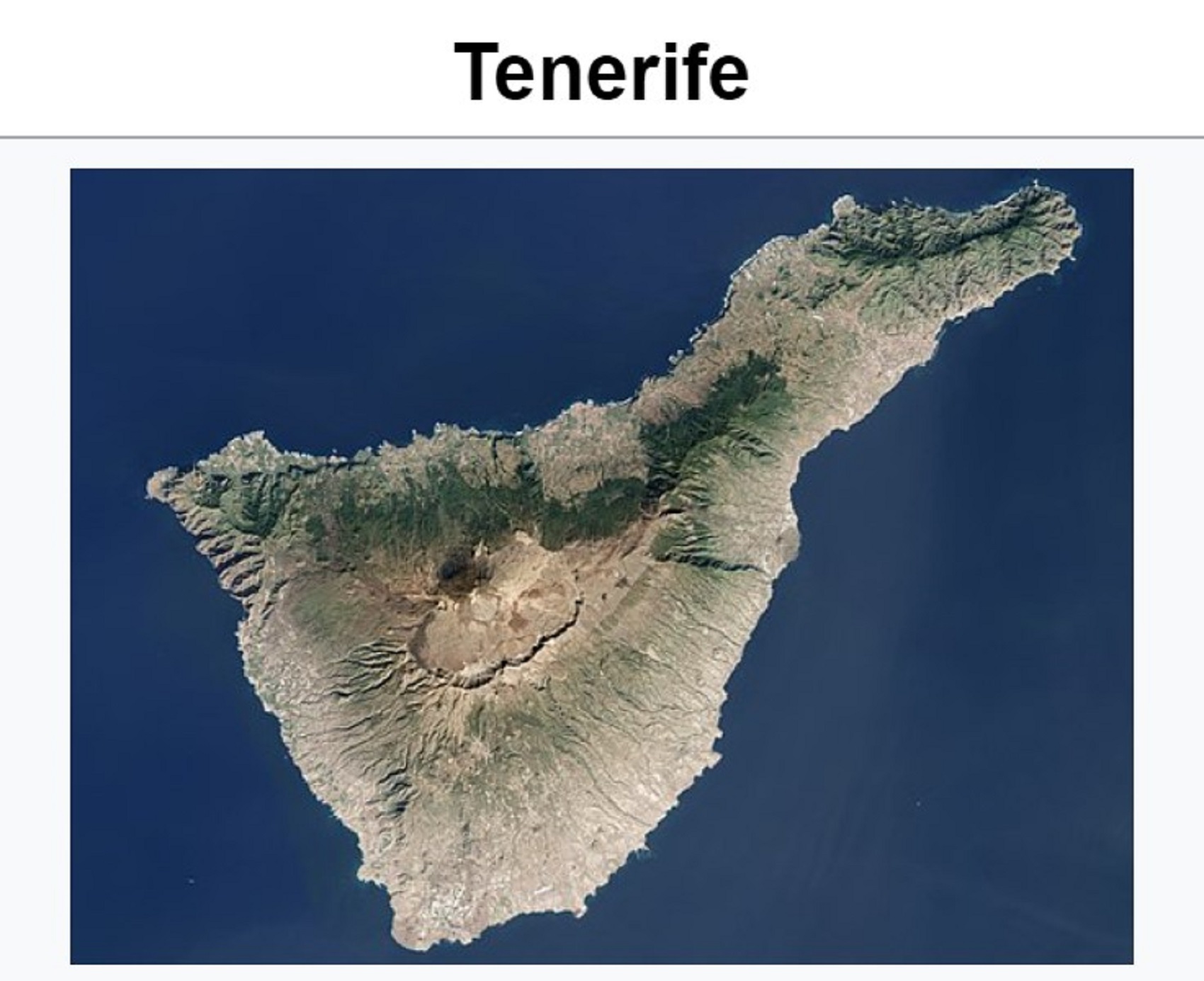
Pic ref
Tenerife Island
“Tenerife is the largest and most populous island of the Canary Islands. It is home to 43% of the total population of the archipelago and with a land area of 2,034 square kilometers (785 sq mi). The name Tenerife comes from Guanche teni (mountain) + ife (snow) (literally snow mountain).” ref
“The island’s indigenous people, the Guanche Berbers, referred to the island as Achinet or Chenet in their language (variant spellings are found in the literature). According to Pliny the Younger, Berber king Juba II sent an expedition to the Canary Islands and Madeira; he named the Canary Islands for the particularly ferocious dogs (canaria) on the island. Juba II and the ancient Romans called the island of Tenerife Nivaria, from the Latin word nix (nsg.; gsg. nivis, npl. nives), meaning “snow”, after the snow-covered peak of the Mount Teide volcano. Later maps dating to the 14th and 15th century, drawn by mapmakers such as Bontier and Le Verrier, called the island Isla del Infierno, (“Hell Island”), due to Mount Teide’s volcanic eruptions and other volcanic activity.” ref
“Although the name given to the island by the Benahoaritas (the indigenous peoples of La Palma) was derived from the words teni (“mountain”) and ife (“white”),[citation needed] after the island was colonized by the Spanish the name was modified by Spanish phonology: the letter “r” was added to link the two words, producing the single word Tenerife. However, throughout history, other explanations for the origin of island’s name have been proposed. For example, the 18th-century historians Juan Núñez de la Peña and Tomás Arias Marín de Cubas, among others, suggested that the indigenous peoples might have named the island for the famous Guanche king, Tinerfe, nicknamed “the Great”, who ruled Tenerife before the Canary Islands were conquered by Castile.” ref
“The earliest known human settlement in the islands date to around 200 BCE, by Berbers known as the Guanches. However, the Cave of the Guanches in the municipality of Icod de los Vinos in the north of Tenerife, has provided the oldest chronologies of the Canary Islands, with dates around the sixth century BCE. Regarding the technological level, the Guanches can be framed among the peoples of the Stone Age, although this terminology is rejected due to the ambiguity that it presents. The Guanche culture is characterized by an advanced cultural development, possibly related to the Berber cultural features imported from North Africa and a poor technological development, determined by the scarcity of raw materials, especially minerals that allow the extraction of metals. The main activity was grazing, although the population were also engaged in agriculture, as well as fishing and the collection of shellfish from the shore or using fishing craft.” ref
“As for beliefs, the Guanche religion was polytheistic although the astral cult was widespread. Beside him, there was an animistic religiosity that sacralized certain places, mainly rocks, and mountains. Among the main Guanche gods could be highlighted; Achamán (god of the sky and supreme creator), Chaxiraxi (mother goddess identified later with the Virgin of Candelaria), Magec (god of the sun), and Guayota (the demon) among many other gods and ancestral spirits. Especially singular was the cult to the dead, practicing the mummification of corpses. In addition, small lithic and clay figurines of the anthropomorphic and zoomorphic type associated with rituals, interpreted as idols, have appeared on the island. Among these stands out the so-called Idol of Guatimac, which is believed to represent a genius or protective spirit.” ref
“The oldest mountain ranges in Tenerife rose from the Atlantic Ocean by a volcanic eruption which gave birth to the island around twelve million years ago. The island as it is today was formed three million years ago by the fusion of three islands made up of the mountain ranges of Anaga, Teno, and Valle de San Lorenzo, due to volcanic activity from Teide. The volcano is visible from most parts of the island today, and the crater is 17 kilometers (11 miles) long at some points. Tenerife is the largest island of the Canary Islands and the Macaronesia region.” ref
“Tenerife is characterized by a generally dry, warm climate. The island, which lies at the same latitude as central Florida, enjoys a warm tropical climate with an average of 18–20 °C (64–68 °F) in the winter and 24–26 °C (75–79 °F) in the summer. It has a high annual total of days of sunshine, and low precipitation in the coastal areas. The moderate climate of Tenerife is controlled to a great extent by the tradewinds, whose humidity is condensed principally over the north and northeast of the island, creating cloud banks that range between 600 and 1,800 meters (2,000 and 5,900 feet) in height. The cold sea currents of the Canary Islands also have a cooling effect on the coasts and its beaches, while the topography of the landscape plays a role in climatic differences on the island with its many valleys. The moderating effect of the marine air makes extreme heat a rare occurrence and frost an impossibility at sea level. The lowest recorded temperature in downtown Santa Cruz is 8.1 °C (46.6 °F), the coldest month on record still had a relatively mild average temperature of 15.8 °C (60.4 °F).” ref
“Summer temperatures are highest in August, with an average high of 29 °C (84 °F) in Santa Cruz, similar to those of places as far north as Barcelona and Majorca, because of the greater maritime influence. At a higher elevation in San Cristóbal de La Laguna, the climate transitions to a Mediterranean climate with higher precipitation amounts and lower temperatures year-round. The climate of Santa Cruz is very typical of the Canaries, albeit only slightly warmer than the climate of Las Palmas. Major climatic contrasts on the island are evident, especially during the winter months when it is possible to enjoy the warm sunshine on the coast and experience snow within kilometers, 3,000 meters (10,000 feet) above sea level on Teide. There are also major contrasts at low altitude, where the climate ranges from arid (Köppen BWh) on the southeastern side represented by Santa Cruz de Tenerife to Mediterranean (Csa/Csb) on the northwestern side in Buena Vista del Norte and La Orotava.” ref
“The north and south of Tenerife similarly have different climatic characteristics because of the rain shadow effect. The windward northwestern side of the island receives 73 percent of all precipitation on the island, and the relative humidity of the air is superior and the insolation inferior. The pluviometric maximums are registered on the windward side at an average altitude of between 1,000 and 1,200 meters (3,300 and 3,900 feet), almost exclusively in the La Orotava mountain range. Although climatic differences in rainfall and sunshine on the island exist, overall annual precipitation is low and the summer months from May to September are normally completely dry. Rainfall, similarly to that of Southern California, can also be extremely erratic from one year to another.” ref
“Tenerife is a rugged and volcanic island sculpted by successive eruptions throughout its history. There are four historically recorded volcanic eruptions, none of which has led to casualties. The first occurred in 1704, when the Arafo, Fasnia, and Siete Fuentes volcanoes erupted simultaneously. Two years later, in 1706, the greatest eruption occurred at Trevejo. This volcano produced great quantities of lava which buried the city and port of Garachico. The last eruption of the 18th century happened in 1798 at Cañadas de Teide, in Chahorra. Finally, and most recently, in 1909 that formed the Chinyero cinder cone, in the municipality of Santiago del Teide, erupted.” ref
“The island is located between 28° and 29° N and the 16° and 17° W meridian. It is situated north of the Tropic of Cancer, occupying a central position between the other Canary Islands of Gran Canaria, La Gomera, and La Palma. The island is about 300 km (186 mi) from the African coast, and approximately 1,000 km (621 mi) from the Iberian Peninsula. Tenerife is the largest island of the Canary Islands archipelago, with a surface area of 2,034.38 km2 (785 sq mi) and has the longest coastline, amounting to 342 km (213 mi).” ref
“In addition, the highest point, Mount Teide, with an elevation of 3,715 m (12,188 ft) above sea level is the highest point in all of Spain, is also the third-largest volcano in the world from its base in the bottom of the sea. For this reason, Tenerife is the 10th-highest island worldwide. It comprises about 200 small barren islets or large rocks including Roques de Anaga, Roque de Garachico, and Fasnia adding a further 213,835 m2 (2,301,701 sq ft) to the total area.” ref
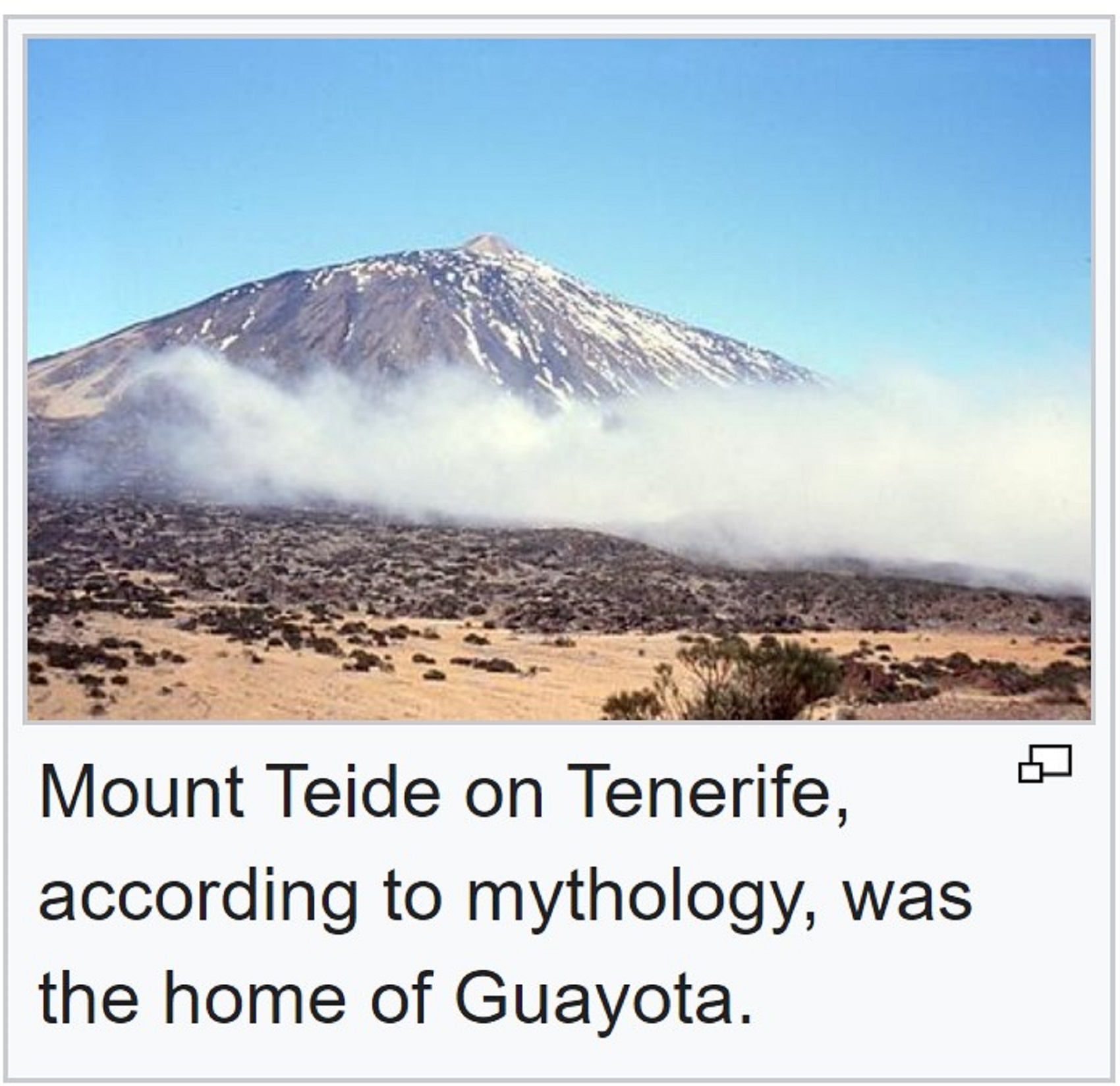
Pic ref
Guayota Principal Malignant Deity
“Guayota, in Guanche mythology of Tenerife (the Canary Islands), was the principal malignant deity and Achamán‘s adversary. Mount Teide on Tenerife, according to mythology, was the home of Guayota. According to Guanche legend, Guayota lived inside the Teide volcano, one of the gateways to the underworld. He was said to be represented as a black dog and was accompanied by demons, also in the form of black dogs, known as tibicenas.” ref
“According to legend, Guayota kidnapped Magec (the sun) and shut it up in Teide, plunging the world into darkness. Humans prayed to Achamán who saved Magec and instead locked Guayota up in Teide. Guayota is the king of evil genies, and was worshiped on the island of Tenerife in the Guanche religion. Guayota shares features similar to other malignant deity-inhabitants of volcanoes as in the case of the goddess Pele in Hawaiian mythology, who lived in the Kīlauea volcano and was regarded by the native Hawaiians as responsible for the eruptions of the volcano.” ref

ref, ref, ref, ref, ref, ref, ref, ref, ref, ref, ref, ref, ref, ref, ref, ref, ref
“The shaman is, above all, a connecting figure, bridging several worlds for his people, traveling between this world, the underworld, and the heavens. He transforms himself into an animal and talks with ghosts, the dead, the deities, and the ancestors. He dies and revives. He brings back knowledge from the shadow realm, thus linking his people to the spirits and places which were once mythically accessible to all.–anthropologist Barbara Meyerhoff” ref
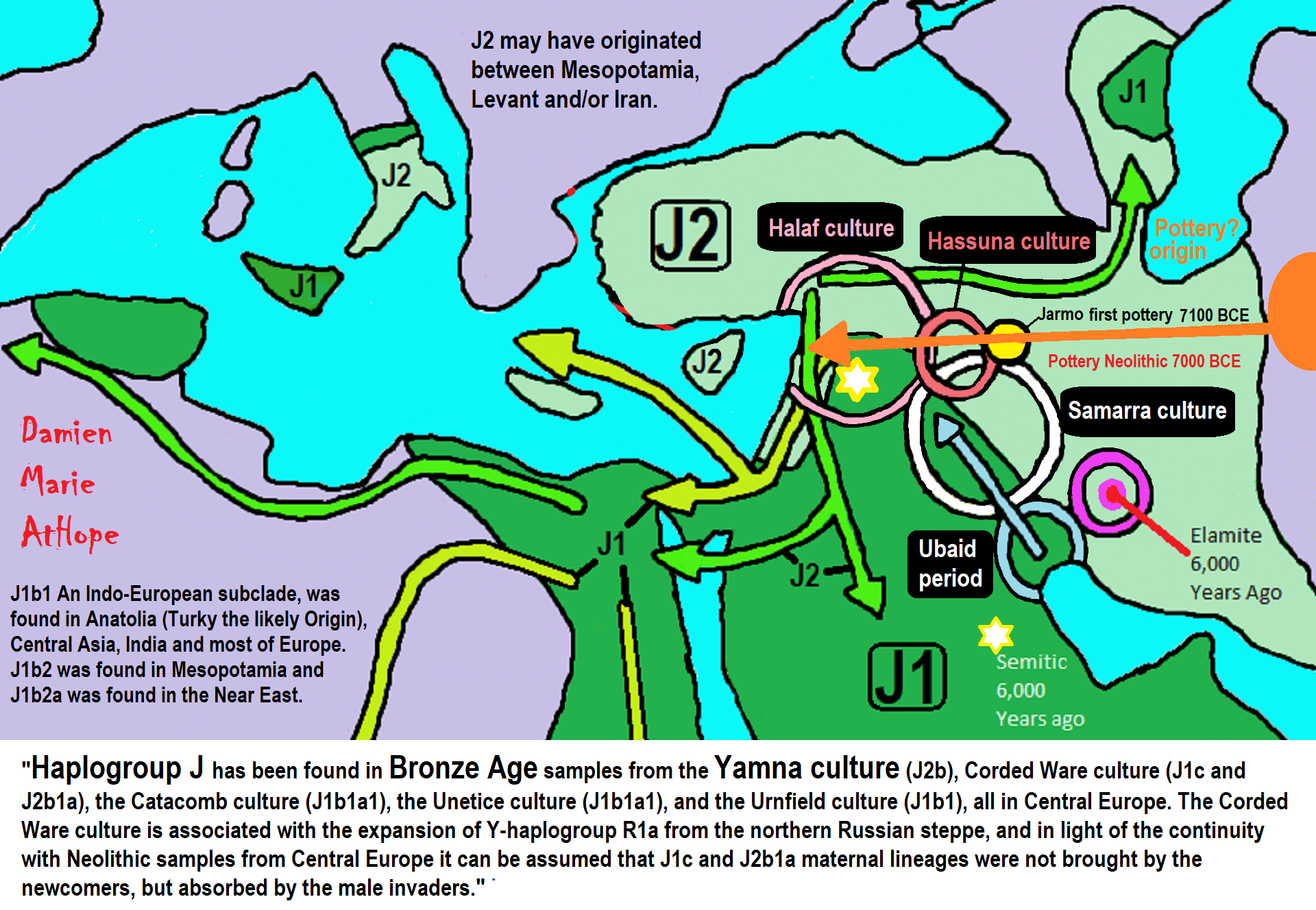

ref, ref, ref, ref, ref, ref, ref, ref
“There are two geographically plausible routes that have been proposed for humans to emerge from Africa: through the current Egypt and Sinai (Northern Route), or through Ethiopia, the Bab el Mandeb strait, and the Arabian Peninsula (Southern Route).” ref
“Although there is a general consensus on the African origin of early modern humans, there is disagreement about how and when they dispersed to Eurasia. This paper reviews genetic and Middle Stone Age/Middle Paleolithic archaeological literature from northeast Africa, Arabia, and the Levant to assess the timing and geographic backgrounds of Upper Pleistocene human colonization of Eurasia. At the center of the discussion lies the question of whether eastern Africa alone was the source of Upper Pleistocene human dispersals into Eurasia or were there other loci of human expansions outside of Africa? The reviewed literature hints at two modes of early modern human colonization of Eurasia in the Upper Pleistocene: (i) from multiple Homo sapiens source populations that had entered Arabia, South Asia, and the Levant prior to and soon after the onset of the Last Interglacial (MIS-5), (ii) from a rapid dispersal out of East Africa via the Southern Route (across the Red Sea basin), dating to ~74,000-60,000 years ago.” ref
“Within Africa, Homo sapiens dispersed around the time of its speciation, roughly 300,000 years ago. The so-called “recent dispersal” of modern humans took place about 70–50,000 years ago. It is this migration wave that led to the lasting spread of modern humans throughout the world. The coastal migration between roughly 70,000 and 50,000 years ago is associated with mitochondrial haplogroups M and N, both derivative of L3. Europe was populated by an early offshoot that settled the Near East and Europe less than 55,000 years ago. Modern humans spread across Europe about 40,000 years ago, possibly as early as 43,000 years ago, rapidly replacing the Neanderthal population.” ref, ref
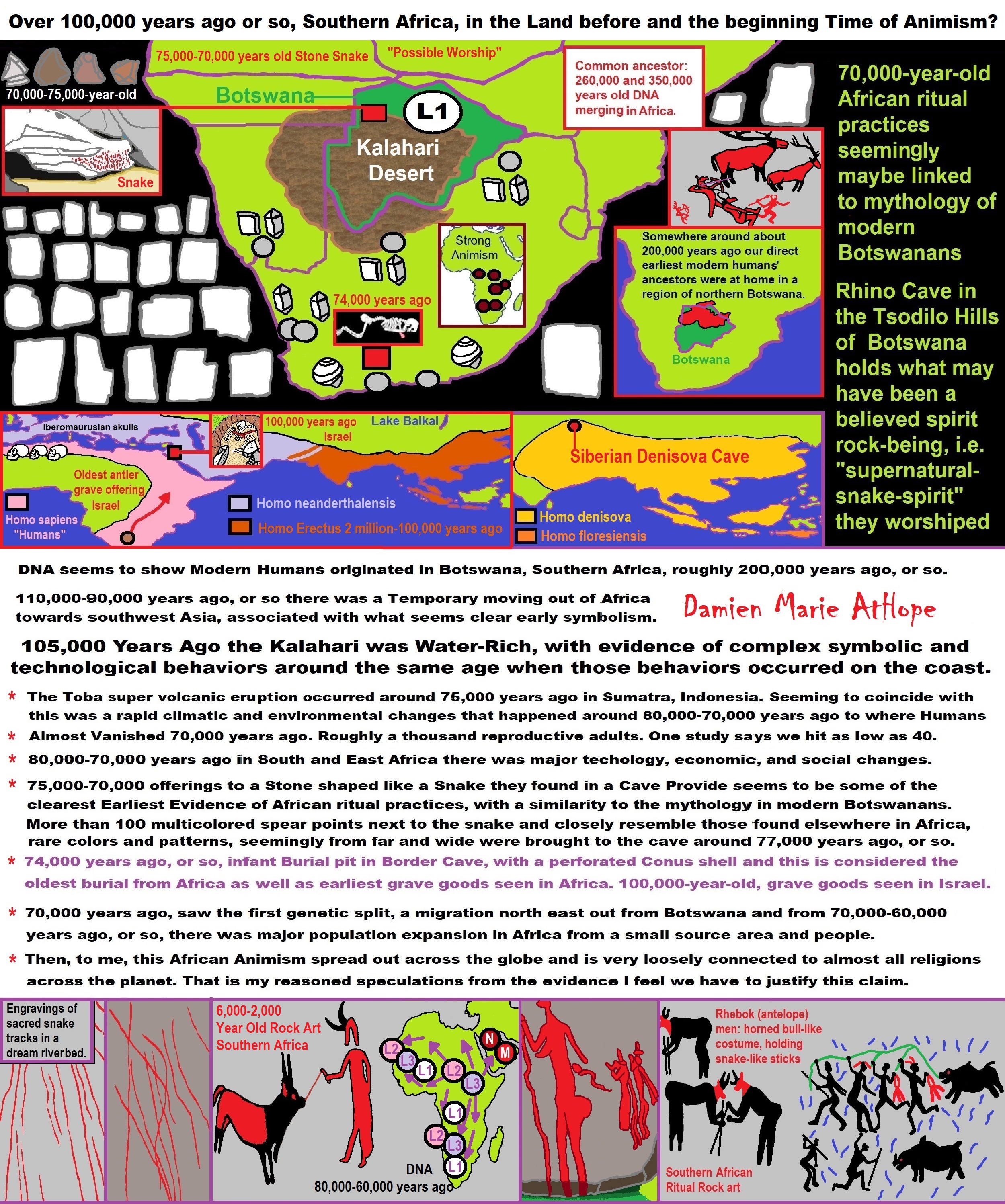
ref, ref, ref, ref, ref, ref, ref, ref, ref, ref, ref, ref, ref, ref, ref, ref, ref, ref, ref, ref, ref, ref, ref, ref, ref, ref, ref, ref, ref, ref, ref, ref, ref, ref, ref, ref, ref, ref, ref, ref, ref, ref, ref, ref, ref, ref, ref, ref, ref, ref, ref, ref
Animism: a belief among some indigenous people, young children, or all religious people!
Over 100,000 years ago or so, Southern Africa, in the Land before and the beginning Time of Animism: LINK

ref, ref, ref, ref, ref, ref, ref, ref, ref, ref, ref, ref, ref, ref, ref, ref, ref, ref, ref, ref, ref, ref, ref, ref, ref, ref, ref, ref, ref, ref, ref, ref, ref, ref, ref, ref, ref, ref, ref, ref, ref, ref, ref, ref, ref, ref, ref, ref, ref, ref, ref, ref, ref, ref, ref, ref, ref, ref, ref, ref,
Explaining the Earliest Religious Expression, that of Animism (beginning 100,000 to 70,000 years ago?) to Totemism (beginning 30,000 to 3,000 years ago?) in Southern Africa: LINK

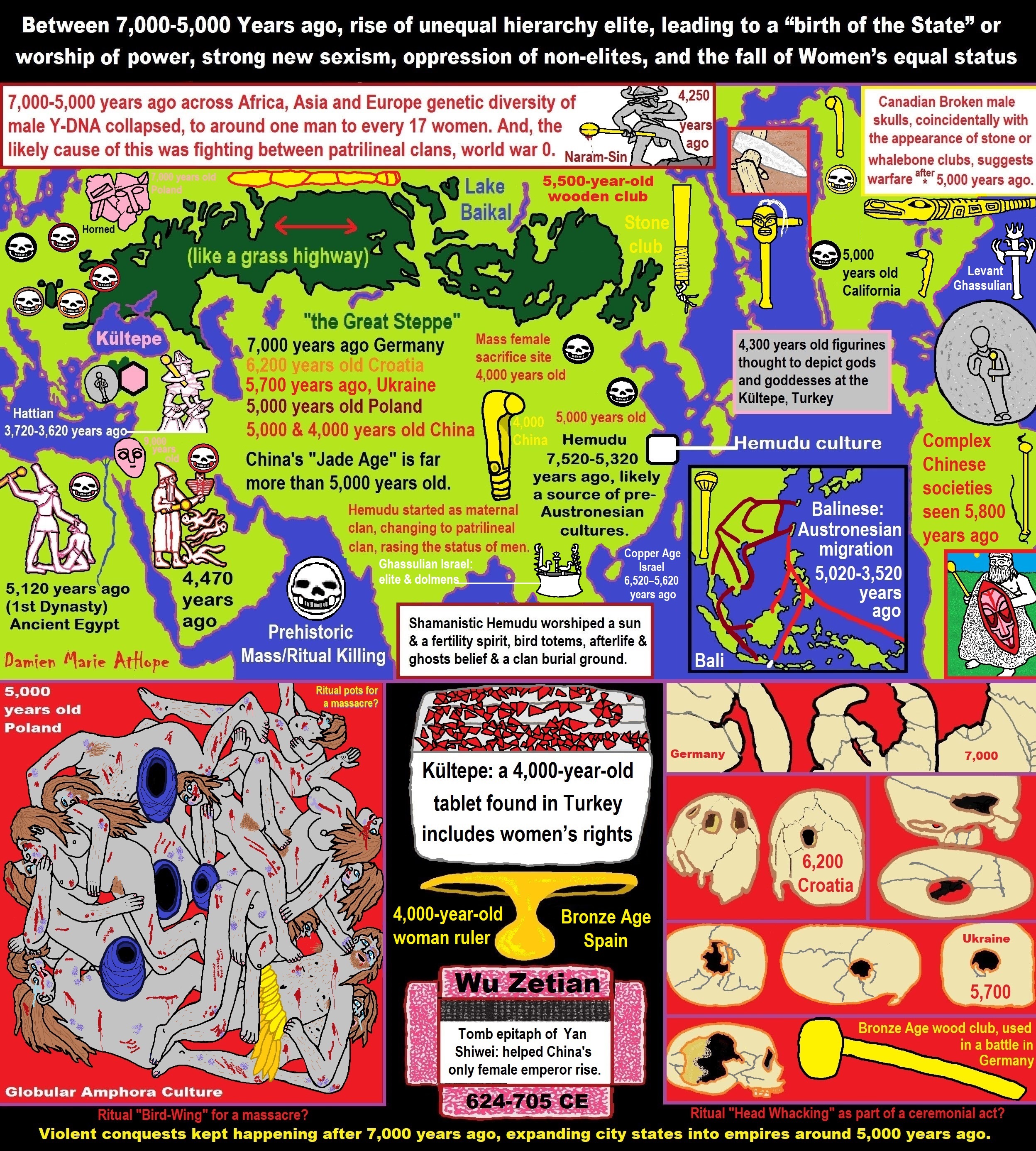
ref, ref, ref, ref, ref, ref, ref, ref, ref, ref, ref, ref, ref, ref, ref, ref, ref, ref, ref, ref, ref, ref, ref, ref, ref, ref, ref, ref, ref, ref, ref, ref, ref, ref, ref, ref, ref, ref, ref, ref, ref, ref, ref, ref, ref, ref, ref, ref, ref, ref, ref, ref, ref, ref, ref, ref, ref, ref, ref, ref, ref, ref, ref, ref, ref, ref, ref, ref, ref, ref, ref, ref, ref, ref, ref, ref, ref, ref, ref, ref, ref, ref, ref, ref, ref, ref, ref, ref, ref, ref

Seated Woman of Çatalhöyük
“The Seated Woman of Çatalhöyük (also Çatal Höyük) is a baked-clay, nude female form, seated between feline-headed arm-rests. It is generally thought to depict a corpulent and fertile Mother goddess in the process of giving birth while seated on her throne, which has two hand rests in the form of feline (lioness, leopard, or panther) heads in a Mistress of Animals motif. The statuette, one of several iconographically similar ones found at the site, is associated to other corpulent prehistoric goddess figures, of which the most famous is the Venus of Willendorf. It is a neolithic sculpture shaped by an unknown artist, and was completed in approximately 6000 BCE.” ref
Kubaba
“Kubaba is the only queen on the Sumerian King List, which states she reigned for 100 years – roughly in the Early Dynastic III period (ca. 2500–2330 BCE) of Sumerian history. A connection between her and a goddess known from Hurro–Hittite and later Luwian sources cannot be established on the account of spatial and temporal differences. Kubaba is one of very few women to have ever ruled in their own right in Mesopotamian history. Most versions of the king list place her alone in her own dynasty, the 3rd Dynasty of Kish, following the defeat of Sharrumiter of Mari, but other versions combine her with the 4th dynasty, that followed the primacy of the king of Akshak. Before becoming monarch, the king list says she was an alewife, brewess or brewster, terms for a woman who brewed alcohol.” ref
“Kubaba was a Syrian goddess associated particularly closely with Alalakh and Carchemish. She was adopted into the Hurrian and Hittite pantheons as well. After the fall of the Hittite empire, she continued to be venerated by Luwians. A connection between her and the similarly named legendary Sumerian queen Kubaba of Kish, while commonly proposed, cannot be established due to spatial and temporal differences. Emmanuel Laroche proposed in 1960 that Kubaba and Cybele were one and the same. This view is supported by Mark Munn, who argues that the Phrygian name Kybele developed from Lydian adjective kuvavli, first changed into kubabli and then simplified into kuballi, and finally kubelli. However, such an adjective is a purely speculative construction.” ref
Cybele
“Cybele (Phrygian: “Kubileya/Kubeleya Mother”, perhaps “Mountain Mother”) is an Anatolian mother goddess; she may have a possible forerunner in the earliest neolithic at Çatalhöyük, where statues of plump women, sometimes sitting, have been found in excavations. Phrygia‘s only known goddess, she was probably its national deity. Greek colonists in Asia Minor adopted and adapted her Phrygian cult and spread it to mainland Greece and to the more distant western Greek colonies around the 6th century BCE. In Greece, Cybele met with a mixed reception. She became partially assimilated to aspects of the Earth-goddess Gaia, of her possibly Minoan equivalent Rhea, and of the harvest–mother goddess Demeter. Some city-states, notably Athens, evoked her as a protector, but her most celebrated Greek rites and processions show her as an essentially foreign, exotic mystery-goddess who arrives in a lion-drawn chariot to the accompaniment of wild music, wine, and a disorderly, ecstatic following.” ref
“Uniquely in Greek religion, she had a eunuch mendicant priesthood. Many of her Greek cults included rites to a divine Phrygian castrate shepherd-consort Attis, who was probably a Greek invention. In Greece, Cybele became associated with mountains, town and city walls, fertile nature, and wild animals, especially lions. In Rome, Cybele became known as Magna Mater (“Great Mother”). The Roman State adopted and developed a particular form of her cult after the Sibylline oracle in 205 BCE recommended her conscription as a key religious ally in Rome’s second war against Carthage (218 to 201 BCE). Roman mythographers reinvented her as a Trojan goddess, and thus an ancestral goddess of the Roman people by way of the Trojan prince Aeneas. As Rome eventually established hegemony over the Mediterranean world, Romanized forms of Cybele’s cults spread throughout Rome’s empire. Greek and Roman writers debated and disputed the meaning and morality of her cults and priesthoods, which remain controversial subjects in modern scholarship.” ref
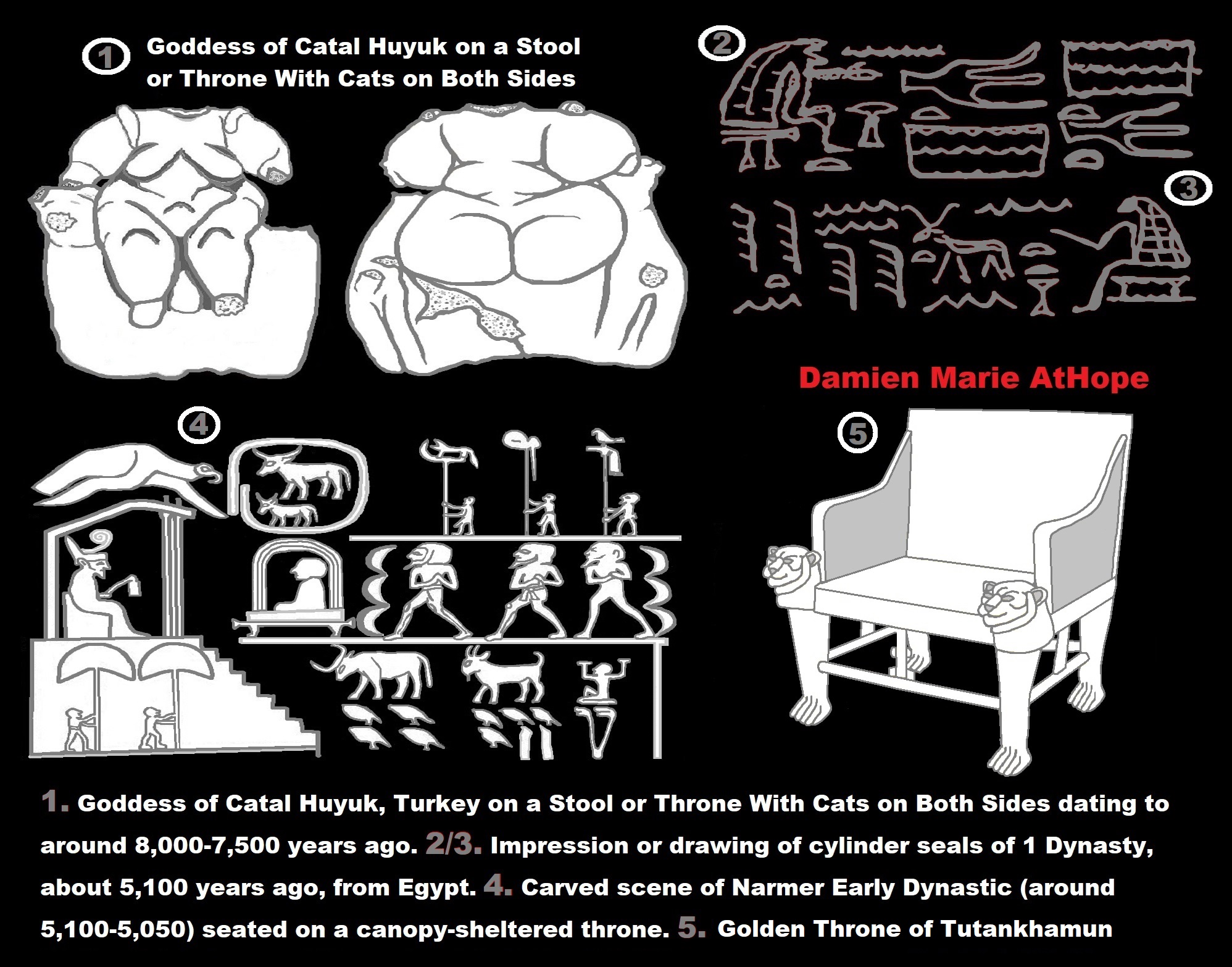

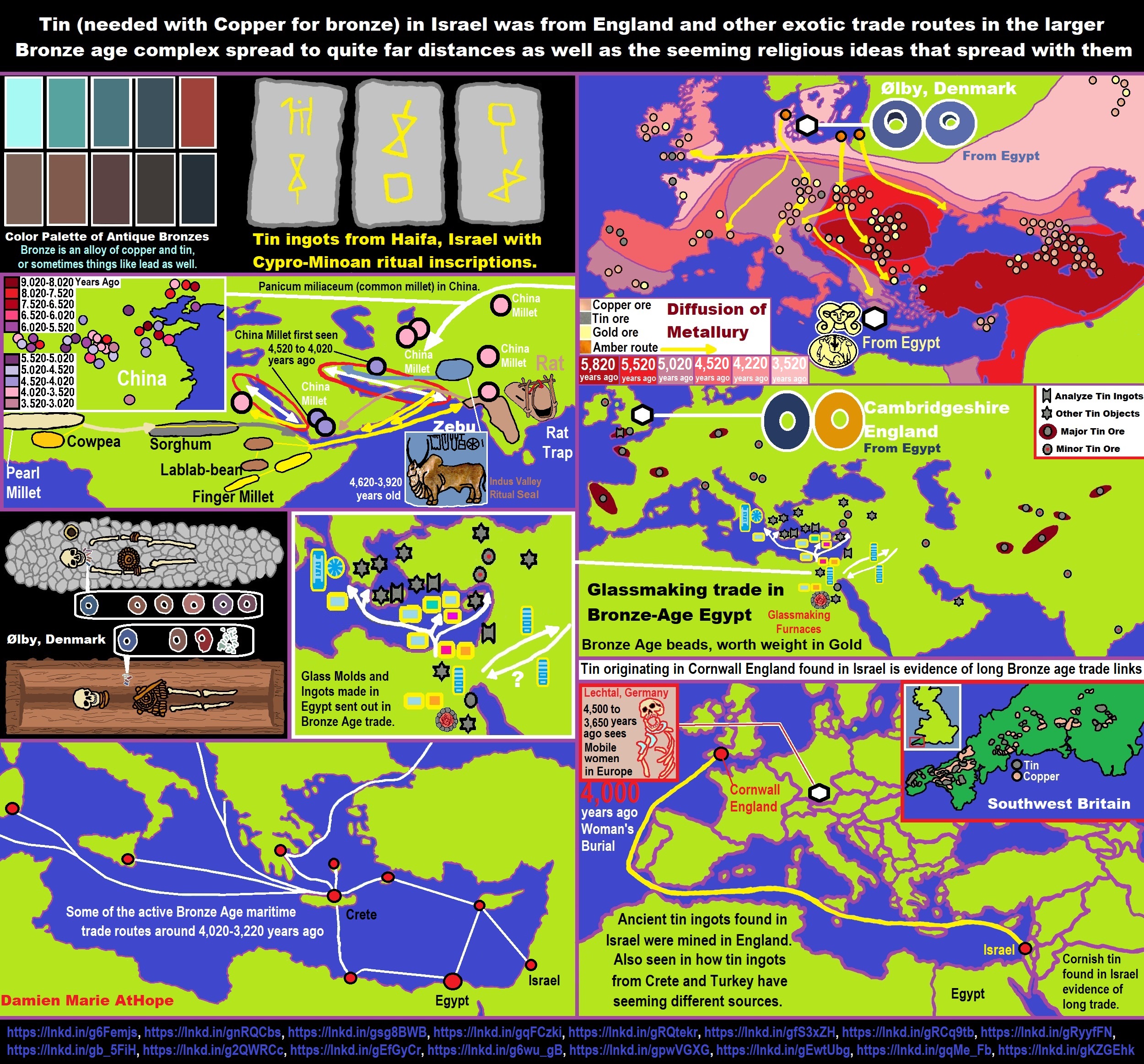

- From a Gerzeh/Naqada II Late Predynastic Egyptian palette with a goddess “Bat/Hathor” cow-head sun/stars motif.
- From a Hierakonpolis late Gerzeh/Naqada II Predynastic or early Naqada III Proto-Dynastic Egyptian porphyry fluted bowl with two reliefs on the rim, one of which was a goddess “Hathor/Bat” cow-head sun/stars motif.
- From an Abydos tomb, u-210 which held a small seal with a goddess “Bat/Hathor” sun/stars motif from the Gerzeh/Naqada II Late Predynastic Egyptian period.
- A Mongolian Copper Age bull sun/star shamanism petroglyph
- A Mongolian Bronze Age deer sun/star shamanism petroglyph symbol.
- A Kyrgyzstan Saimaly-Tash possibly Bronze Age shamanism cow-sun person symbol petroglyph.
- Similar X-ray style images among different peoples of the North from Siberia to Central Asia with shamanism petroglyphs of horned animals with sun symbols from possibly as old as the Neolithic to the Bronze Age. ref, ref, ref
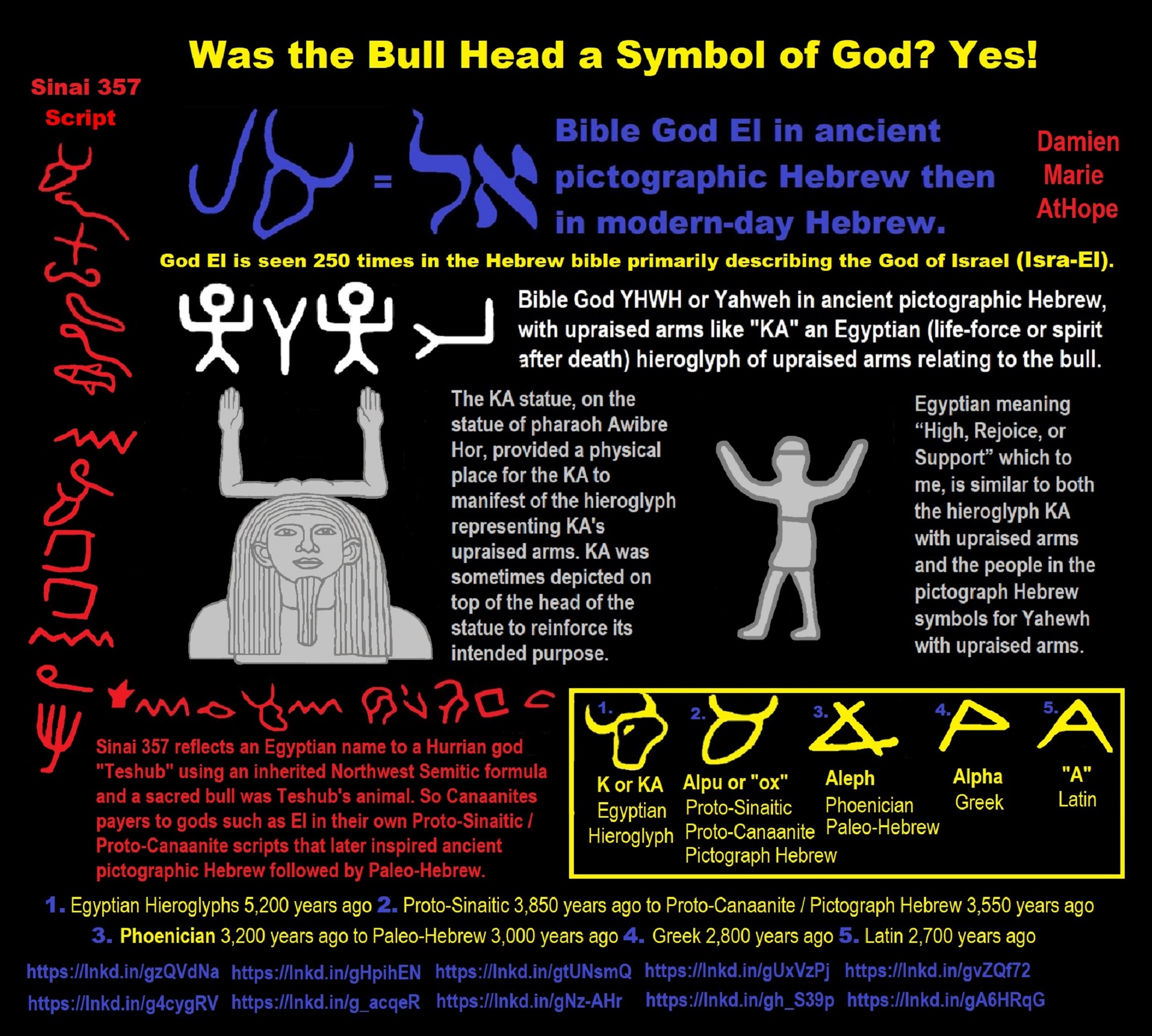


Animism: Respecting the Living World by Graham Harvey
“How have human cultures engaged with and thought about animals, plants, rocks, clouds, and other elements in their natural surroundings? Do animals and other natural objects have a spirit or soul? What is their relationship to humans? In this new study, Graham Harvey explores current and past animistic beliefs and practices of Native Americans, Maori, Aboriginal Australians, and eco-pagans. He considers the varieties of animism found in these cultures as well as their shared desire to live respectfully within larger natural communities. Drawing on his extensive casework, Harvey also considers the linguistic, performative, ecological, and activist implications of these different animisms.” ref

My thoughts on Religion Evolution with external links for more info:
- (Pre-Animism Africa mainly, but also Europe, and Asia at least 300,000 years ago), (Pre-Animism – Oxford Dictionaries)
- (Animism Africa around 100,000 years ago), (Animism – Britannica.com)
- (Totemism Europe around 50,000 years ago), (Totemism – Anthropology)
- (Shamanism Siberia around 30,000 years ago), (Shamanism – Britannica.com)
- (Paganism Turkey around 12,000 years ago), (Paganism – BBC Religion)
- (Progressed Organized Religion “Institutional Religion” Egypt around 5,000 years ago), (Ancient Egyptian Religion – Britannica.com)
- (CURRENT “World” RELIGIONS after 4,000 years ago) (Origin of Major Religions – Sacred Texts)
- (Early Atheistic Doubting at least by 2,600 years ago) (History of Atheism – Wikipedia)
“Religion is an Evolved Product” and Yes, Religion is Like Fear Given Wings…
Atheists talk about gods and religions for the same reason doctors talk about cancer, they are looking for a cure, or a firefighter talks about fires because they burn people and they care to stop them. We atheists too often feel a need to help the victims of mental slavery, held in the bondage that is the false beliefs of gods and the conspiracy theories of reality found in religions.
Understanding Religion Evolution:
- Pre-Animism (at least 300,000 years ago)
- Animism (Africa: 100,000 years ago)
- Totemism (Europe: 50,000 years ago)
- Shamanism (Siberia: 30,000 years ago)
- Paganism (Turkey: 12,000 years ago)
- Progressed organized religion (Egypt: 5,000 years ago), (Egypt, the First Dynasty 5,150 years ago)
- CURRENT “World” RELIGIONS (after 4,000 years ago)
- Early Atheistic Doubting (at least by 2,600 years ago)
“An Archaeological/Anthropological Understanding of Religion Evolution”
It seems ancient peoples had to survived amazing threats in a “dangerous universe (by superstition perceived as good and evil),” and human “immorality or imperfection of the soul” which was thought to affect the still living, leading to ancestor worship. This ancestor worship presumably led to the belief in supernatural beings, and then some of these were turned into the belief in gods. This feeble myth called gods were just a human conceived “made from nothing into something over and over, changing, again and again, taking on more as they evolve, all the while they are thought to be special,” but it is just supernatural animistic spirit-belief perceived as sacred.
Quick Evolution of Religion?
Pre-Animism (at least 300,000 years ago) pre-religion is a beginning that evolves into later Animism. So, Religion as we think of it, to me, all starts in a general way with Animism (Africa: 100,000 years ago) (theoretical belief in supernatural powers/spirits), then this is physically expressed in or with Totemism (Europe: 50,000 years ago) (theoretical belief in mythical relationship with powers/spirits through a totem item), which then enlists a full-time specific person to do this worship and believed interacting Shamanism (Siberia/Russia: 30,000 years ago) (theoretical belief in access and influence with spirits through ritual), and then there is the further employment of myths and gods added to all the above giving you Paganism (Turkey: 12,000 years ago) (often a lot more nature-based than most current top world religions, thus hinting to their close link to more ancient religious thinking it stems from). My hypothesis is expressed with an explanation of the building of a theatrical house (modern religions development). Progressed organized religion (Egypt: 5,000 years ago) with CURRENT “World” RELIGIONS (after 4,000 years ago).
Historically, in large city-state societies (such as Egypt or Iraq) starting around 5,000 years ago culminated to make religion something kind of new, a sociocultural-governmental-religious monarchy, where all or at least many of the people of such large city-state societies seem familiar with and committed to the existence of “religion” as the integrated life identity package of control dynamics with a fixed closed magical doctrine, but this juggernaut integrated religion identity package of Dogmatic-Propaganda certainly did not exist or if developed to an extent it was highly limited in most smaller prehistoric societies as they seem to lack most of the strong control dynamics with a fixed closed magical doctrine (magical beliefs could be at times be added or removed). Many people just want to see developed religious dynamics everywhere even if it is not. Instead, all that is found is largely fragments until the domestication of religion.
Religions, as we think of them today, are a new fad, even if they go back to around 6,000 years in the timeline of human existence, this amounts to almost nothing when seen in the long slow evolution of religion at least around 70,000 years ago with one of the oldest ritual worship. Stone Snake of South Africa: “first human worship” 70,000 years ago. This message of how religion and gods among them are clearly a man-made thing that was developed slowly as it was invented and then implemented peace by peace discrediting them all. Which seems to be a simple point some are just not grasping how devastating to any claims of truth when we can see the lie clearly in the archeological sites.
I wish people fought as hard for the actual values as they fight for the group/clan names political or otherwise they think support values. Every amount spent on war is theft to children in need of food or the homeless kept from shelter.
Here are several of my blog posts on history:
- To Find Truth You Must First Look
- (Magdalenian/Iberomaurusian) Connections to the First Paganists of the early Neolithic Near East Dating from around 17,000 to 12,000 Years Ago
- Natufians: an Ancient People at the Origins of Agriculture and Sedentary Life
- Possible Clan Leader/Special “MALE” Ancestor Totem Poles At Least 13,500 years ago?
- Jewish People with DNA at least 13,200 years old, Judaism, and the Origins of Some of its Ideas
- Baltic Reindeer Hunters: Swiderian, Lyngby, Ahrensburgian, and Krasnosillya cultures 12,020 to 11,020 years ago are evidence of powerful migratory waves during the last 13,000 years and a genetic link to Saami and the Finno-Ugric peoples.
- The Rise of Inequality: patriarchy and state hierarchy inequality
- Fertile Crescent 12,500 – 9,500 Years Ago: fertility and death cult belief system?
- 12,400 – 11,700 Years Ago – Kortik Tepe (Turkey) Pre/early-Agriculture Cultic Ritualism
- Ritualistic Bird Symbolism at Gobekli Tepe and its “Ancestor Cult”
- Male-Homosexual (female-like) / Trans-woman (female) Seated Figurine from Gobekli Tepe
- Could a 12,000-year-old Bull Geoglyph at Göbekli Tepe relate to older Bull and Female Art 25,000 years ago and Later Goddess and the Bull cults like Catal Huyuk?
- Sedentism and the Creation of goddesses around 12,000 years ago as well as male gods after 7,000 years ago.
- Alcohol, where Agriculture and Religion Become one? Such as Gobekli Tepe’s Ritualistic use of Grain as Food and Ritual Drink
- Neolithic Ritual Sites with T-Pillars and other Cultic Pillars
- Paganism: Goddesses around 12,000 years ago then Male Gods after 7,000 years ago
- First Patriarchy: Split of Women’s Status around 12,000 years ago & First Hierarchy: fall of Women’s Status around 5,000 years ago.
- Natufians: an Ancient People at the Origins of Agriculture and Sedentary Life
- J DNA and the Spread of Agricultural Religion (paganism)
- Paganism: an approximately 12,000-year-old belief system
- Paganism 12,000 years old: related to “Anarchism and Socialism” (Pre-Capitalism)
- Shaman burial in Israel 12,000 years ago and the Shamanism Phenomena
- Need to Mythicized: gods and goddesses
- 12,000 – 7,000 Years Ago – Paleo-Indian Culture (The Americas)
- 12,000 – 2,000 Years Ago – Indigenous-Scandinavians (Nordic)
- Norse did not wear helmets with horns?
- Pre-Pottery Neolithic Skull Cult around 11,500 to 8,400 Years Ago?
- 10,400 – 10,100 Years Ago, in Turkey the Nevail Cori Religious Settlement
- 9,000-6,500 Years Old Submerged Pre-Pottery/Pottery Neolithic Ritual Settlements off Israel’s Coast
- Catal Huyuk “first religious designed city” around 9,500 to 7,700 years ago (Turkey)
- Cultic Hunting at Catal Huyuk “first religious designed city”
- Special Items and Art as well as Special Elite Burials at Catal Huyuk
- New Rituals and Violence with the appearance of Pottery and People?
- Haplogroup N and its related Uralic Languages and Cultures
- Ainu people, Sámi people, Native Americans, the Ancient North Eurasians, and Paganistic-Shamanism with Totemism
- Ideas, Technology and People from Turkey, Europe, to China and Back again 9,000 to 5,000 years ago?
- First Pottery of Europe and the Related Cultures
- 9,000 years old Neolithic Artifacts Judean Desert and Hills Israel
- 9,000-7,000 years-old Sex and Death Rituals: Cult Sites in Israel, Jordan, and the Sinai
- 9,000-8500 year old Horned Female shaman Bad Dürrenberg Germany
- Neolithic Jewelry and the Spread of Farming in Europe Emerging out of West Turkey
- 8,600-year-old Tortoise Shells in Neolithic graves in central China have Early Writing and Shamanism
- Swing of the Mace: the rise of Elite, Forced Authority, and Inequality begin to Emerge 8,500 years ago?
- Migrations and Changing Europeans Beginning around 8,000 Years Ago
- My “Steppe-Anatolian-Kurgan hypothesis” 8,000/7,000 years ago
- Around 8,000-year-old Shared Idea of the Mistress of Animals, “Ritual” Motif
- Pre-Columbian Red-Paint (red ochre) Maritime Archaic Culture 8,000-3,000 years ago
- 7,522-6,522 years ago Linear Pottery culture which I think relates to Arcane Capitalism’s origins
- Arcane Capitalism: Primitive socialism, Primitive capital, Private ownership, Means of production, Market capitalism, Class discrimination, and Petite bourgeoisie (smaller capitalists)
- 7,500-4,750 years old Ritualistic Cucuteni-Trypillian culture of Moldova, Romania, and Ukraine
- Roots of a changing early society 7,200-6,700 years ago Jordan and Israel
- Agriculture religion (Paganism) with farming reached Britain between about 7,000 to 6,500 or so years ago and seemingly expressed in things like Western Europe’s Long Barrows
- My Thoughts on Possible Migrations of “R” DNA and Proto-Indo-European?
- “Millet” Spreading from China 7,022 years ago to Europe and related Language may have Spread with it leading to Proto-Indo-European
- Proto-Indo-European (PIE), ancestor of Indo-European languages: DNA, Society, Language, and Mythology
- The Dnieper–Donets culture and Asian varieties of Millet from China to the Black Sea region of Europe by 7,022 years ago
- Kurgan 6,000 years ago/dolmens 7,000 years ago: funeral, ritual, and other?
- 7,020 to 6,020-year-old Proto-Indo-European Homeland of Urheimat or proposed home of their Language and Religion
- Ancient Megaliths: Kurgan, Ziggurat, Pyramid, Menhir, Trilithon, Dolman, Kromlech, and Kromlech of Trilithons
- The Mytheme of Ancient North Eurasian Sacred-Dog belief and similar motifs are found in Indo-European, Native American, and Siberian comparative mythology
- Elite Power Accumulation: Ancient Trade, Tokens, Writing, Wealth, Merchants, and Priest-Kings
- Sacred Mounds, Mountains, Kurgans, and Pyramids may hold deep connections?
- Between 7,000-5,000 Years ago, rise of unequal hierarchy elite, leading to a “birth of the State” or worship of power, strong new sexism, oppression of non-elites, and the fall of Women’s equal status
- Paganism 7,000-5,000 years old: related to “Anarchism and Socialism” (Capitalism) (World War 0) Elite & their slaves
- Hell and Underworld mythologies starting maybe as far back as 7,000 to 5,000 years ago with the Proto-Indo-Europeans?
- The First Expression of the Male God around 7,000 years ago?
- White (light complexion skin) Bigotry and Sexism started 7,000 years ago?
- Around 7,000-year-old Shared Idea of the Divine Bird (Tutelary and/or Trickster spirit/deity), “Ritual” Motif
- Nekhbet an Ancient Egyptian Vulture Goddess and Tutelary Deity
- 6,720 to 4,920 years old Ritualistic Hongshan Culture of Inner Mongolia with 5,000-year-old Pyramid Mounds and Temples
- First proto-king in the Balkans, Varna culture around 6,500 years ago?
- 6,500–5,800 years ago in Israel Late Chalcolithic (Copper Age) Period in the Southern Levant Seems to Express Northern Levant Migrations, Cultural and Religious Transfer
- KING OF BEASTS: Master of Animals “Ritual” Motif, around 6,000 years old or older…
- Around 6000-year-old Shared Idea of the Solid Wheel & the Spoked Wheel-Shaped Ritual Motif
- “The Ghassulian Star,” a mysterious 6,000-year-old mural from Jordan; a Proto-Star of Ishtar, Star of Inanna or Star of Venus?
- Religious/Ritual Ideas, including goddesses and gods as well as ritual mounds or pyramids from Northeastern Asia at least 6,000 years old, seemingly filtering to Iran, Iraq, the Mediterranean, Europe, Egypt, and the Americas?
- Maykop (5,720–5,020 years ago) Caucasus region Bronze Age culture-related to Copper Age farmers from the south, influenced by the Ubaid period and Leyla-Tepe culture, as well as influencing the Kura-Araxes culture
- 5-600-year-old Tomb, Mummy, and First Bearded Male Figurine in a Grave
- Kura-Araxes Cultural 5,520 to 4,470 years old DNA traces to the Canaanites, Arabs, and Jews
- Minoan/Cretan (Keftiu) Civilization and Religion around 5,520 to 3,120 years ago
- Evolution Of Science at least by 5,500 years ago
- 5,500 Years old birth of the State, the rise of Hierarchy, and the fall of Women’s status
- “Jiroft culture” 5,100 – 4,200 years ago and the History of Iran
- Stonehenge: Paganistic Burial and Astrological Ritual Complex, England (5,100-3,600 years ago)
- Around 5,000-year-old Shared Idea of the “Tree of Life” Ritual Motif
- Complex rituals for elite, seen from China to Egypt, at least by 5,000 years ago
- Around 5,000 years ago: “Birth of the State” where Religion gets Military Power and Influence
- The Center of the World “Axis Mundi” and/or “Sacred Mountains” Mythology Could Relate to the Altai Mountains, Heart of the Steppe
- Progressed organized religion starts, an approximately 5,000-year-old belief system
- China’s Civilization between 5,000-3,000 years ago, was a time of war and class struggle, violent transition from free clans to a Slave or Elite society
- Origin of Logics is Naturalistic Observation at least by around 5,000 years ago.
- Paganism 5,000 years old: progressed organized religion and the state: related to “Anarchism and Socialism” (Kings and the Rise of the State)
- Ziggurats (multi-platform temples: 4,900 years old) to Pyramids (multi-platform tombs: 4,700 years old)
- Did a 4,520–4,420-year-old Volcano In Turkey Inspire the Bible God?
- Finland’s Horned Shaman and Pre-Horned-God at least 4,500 years ago?
- 4,000-year-Old Dolmens in Israel: A Connected Dolmen Religious Phenomenon?
- Creation myths: From chaos, Ex nihilo, Earth-diver, Emergence, World egg, and World parent
- Bronze Age “Ritual” connections of the Bell Beaker culture with the Corded Ware/Single Grave culture, which were related to the Yamnaya culture and Proto-Indo-European Languages/Religions
- Low Gods (Earth/ Tutelary deity), High Gods (Sky/Supreme deity), and Moralistic Gods (Deity enforcement/divine order)
- The exchange of people, ideas, and material-culture including, to me, the new god (Sky Father) and goddess (Earth Mother) religion between the Cucuteni-Trypillians and others which is then spread far and wide
- Koryaks: Indigenous People of the Russian Far East and Big Raven myths also found in Tlingit, Haida, Tsimshian, and other Indigenous People of North America
- 42 Principles Of Maat (Egyptian Goddess of the justice) around 4,400 years ago, 2000 Years Before Ten Commandments
- “Happy Easter” Well Happy Eostre/Ishter
- 4,320-3,820 years old “Shimao” (North China) site with Totemistic-Shamanistic Paganism and a Stepped Pyramid
- 4,250 to 3,400 Year old Stonehenge from Russia: Arkaim?
- 4,100-year-old beaker with medicinal & flowering plants in a grave of a woman in Scotland
- Early European Farmer ancestry, Kelif el Boroud people with the Cardial Ware culture, and the Bell Beaker culture Paganists too, spread into North Africa, then to the Canary Islands off West Africa
- Flood Accounts: Gilgamesh epic (4,100 years ago) Noah in Genesis (2,600 years ago)
- Paganism 4,000 years old: related to “Anarchism and Socialism” (First Moralistic gods, then the Origin time of Monotheism)
- When was the beginning: TIMELINE OF CURRENT RELIGIONS, which start around 4,000 years ago.
- Early Religions Thought to Express Proto-Monotheistic Systems around 4,000 years ago
- Kultepe? An archaeological site with a 4,000 years old women’s rights document.
- Single God Religions (Monotheism) = “Man-o-theism” started around 4,000 years ago with the Great Sky Spirit/God Tiān (天)?
- Confucianism’s Tiān (Shangdi god 4,000 years old): Supernaturalism, Pantheism or Theism?
- Yes, Your Male God is Ridiculous
- Mythology, a Lunar Deity is a Goddess or God of the Moon
- Sacred Land, Hills, and Mountains: Sami Mythology (Paganistic Shamanism)
- Horse Worship/Sacrifice: mythical union of Ruling Elite/Kingship and the Horse
- The Amorite/Amurru people’s God Amurru “Lord of the Steppe”, relates to the Origins of the Bible God?
- Bronze Age Exotic Trade Routes Spread Quite Far as well as Spread Religious Ideas with Them
- Sami and the Northern Indigenous Peoples Landscape, Language, and its Connection to Religion
- Prototype of Ancient Analemmatic Sundials around 3,900-3,150 years ago and a Possible Solar Connection to gods?
- Judaism is around 3,450 or 3,250 years old. (“Paleo-Hebrew” 3,000 years ago and Torah 2,500 years ago)
- The Weakening of Ancient Trade and the Strengthening of Religions around 3000 years ago?
- Are you aware that there are religions that worship women gods, explain now religion tears women down?
- Animistic, Totemistic, and Paganistic Superstition Origins of bible god and the bible’s Religion.
- Myths and Folklore: “Trickster gods and goddesses”
- Jews, Judaism, and the Origins of Some of its Ideas
- An Old Branch of Religion Still Giving Fruit: Sacred Trees
- Dating the BIBLE: naming names and telling times (written less than 3,000 years ago, provable to 2,200 years ago)
- Did a Volcano Inspire the bible god?
- The Amorite/Amurru people’s God Amurru “Lord of the Steppe”, relates to the Origins of the Bible God?
- Dené–Yeniseian language, Old Copper Complex, and Pre-Columbian Mound Builders?
- No “dinosaurs and humans didn’t exist together just because some think they are in the bible itself”
- Sacred Shit and Sacred Animals?
- Everyone Killed in the Bible Flood? “Nephilim” (giants)?
- Hey, Damien dude, I have a question for you regarding “the bible” Exodus.
- Archaeology Disproves the Bible
- Bible Battle, Just More, Bible Babble
- The Jericho Conquest lie?
- Canaanites and Israelites?
- Accurate Account on how did Christianity Began?
- Let’s talk about Christianity.
- So the 10 commandments isn’t anything to go by either right?
- Misinformed christian
- Debunking Jesus?
- Paulism vs Jesus
- Ok, you seem confused so let’s talk about Buddhism.
- Unacknowledged Buddhism: Gods, Savior, Demons, Rebirth, Heavens, Hells, and Terrorism
- His Foolishness The Dalai Lama
- Yin and Yang is sexist with an ORIGIN around 2,300 years ago?
- I Believe Archaeology, not Myths & Why Not, as the Religious Myths Already Violate Reason!
- Archaeological, Scientific, & Philosophic evidence shows the god myth is man-made nonsense.
- Aquatic Ape Theory/Hypothesis? As Always, Just Pseudoscience.
- Ancient Aliens Conspiracy Theorists are Pseudohistorians
- The Pseudohistoric and Pseudoscientific claims about “Bakoni Ruins” of South Africa
- Why do people think Religion is much more than supernaturalism and superstitionism?
- Religion is an Evolved Product
- Was the Value of Ancient Women Different?
- 1000 to 1100 CE, human sacrifice Cahokia Mounds a pre-Columbian Native American site
- Feminist atheists as far back as the 1800s?
- Promoting Religion as Real is Mentally Harmful to a Flourishing Humanity
- Screw All Religions and Their Toxic lies, they are all fraud
- Forget Religions’ Unfounded Myths, I Have Substantiated “Archaeology Facts.”
- Religion Dispersal throughout the World
- I Hate Religion Just as I Hate all Pseudoscience
- Exposing Scientology, Eckankar, Wicca and Other Nonsense?
- Main deity or religious belief systems
- Quit Trying to Invent Your God From the Scraps of Science.
- Archaeological, Scientific, & Philosophic evidence shows the god myth is man-made nonsense.
- Ancient Alien Conspiracy Theorists: Misunderstanding, Rhetoric, Misinformation, Fabrications, and Lies
- Misinformation, Distortion, and Pseudoscience in Talking with a Christian Creationist
- Judging the Lack of Goodness in Gods, Even the Norse God Odin
- Challenging the Belief in God-like Aliens and Gods in General
- A Challenge to Christian use of Torture Devices?
- Yes, Hinduism is a Religion
- Trump is One of the Most Reactionary Forces of Far-right Christian Extremism
- Was the Bull Head a Symbol of God? Yes!
- Primate Death Rituals
- Christian – “God and Christianity are objectively true”
- Australopithecus afarensis Death Ritual?
- You Claim Global Warming is a Hoax?
- Doubter of Science and Defamer of Atheists?
- I think that sounds like the Bible?
- History of the Antifa (“anti-fascist”) Movements
- Indianapolis Anti-Blasphemy Laws #Free Soheil Rally
- Damien, you repeat the golden rule in so many forms then you say religion is dogmatic?
- Science is a Trustable Methodology whereas Faith is not Trustable at all!
- Was I ever a believer, before I was an atheist?
- Atheists rise in reason
- Mistrust of science?
- Open to Talking About the Definition of ‘God’? But first, we address Faith.
- ‘United Monarchy’ full of splendor and power – Saul, David, and Solomon? Most likely not.
- Is there EXODUS ARCHAEOLOGY? The short answer is “no.”
- Lacking Proof of Bigfoots, Unicorns, and Gods is Just a Lack of Research?
- Religion and Politics: Faith Beliefs vs. Rational Thinking
- Hammer of Truth that lying pig RELIGION: challenged by an archaeologist
- “The Hammer of Truth” -ontology question- What do You Mean by That?
- Navigation of a bad argument: Ad Hominem vs. Attack
- Why is it Often Claimed that Gods have a Gender?
- Why are basically all monotheistic religions ones that have a male god?
- Shifting through the Claims in support of Faith
- Dear Mr. AtHope, The 20th Century is an Indictment of Secularism and a Failed Atheist Century
- An Understanding of the Worldwide Statistics and Dynamics of Terrorist Incidents and Suicide Attacks
- Intoxication and Evolution? Addressing and Assessing the “Stoned Ape” or “Drunken Monkey” Theories as Catalysts in Human Evolution
- Sacred Menstrual cloth? Inanna’s knot, Isis knot, and maybe Ma’at’s feather?
- Damien, why don’t the Hebrews accept the bible stories?
- Dealing with a Troll and Arguing Over Word Meaning
- Knowledge without Belief? Justified beliefs or disbeliefs worthy of Knowledge?
- Afrocentrism and African Religions
- Crecganford @crecganford offers history & stories of the people, places, gods, & culture
- Empiricism-Denier?
I am not an academic. I am a revolutionary that teaches in public, in places like social media, and in the streets. I am not a leader by some title given but from my commanding leadership style of simply to start teaching everywhere to everyone, all manner of positive education.









ref, ref, ref, ref, ref, ref, ref, ref, ref, ref, ref, ref, ref, ref, ref, ref, ref, ref, ref, ref, ref
Low Gods “Earth” or Tutelary deity and High Gods “Sky” or Supreme deity
“An Earth goddess is a deification of the Earth. Earth goddesses are often associated with the “chthonic” deities of the underworld. Ki and Ninhursag are Mesopotamian earth goddesses. In Greek mythology, the Earth is personified as Gaia, corresponding to Roman Terra, Indic Prithvi/Bhūmi, etc. traced to an “Earth Mother” complementary to the “Sky Father” in Proto-Indo-European religion. Egyptian mythology exceptionally has a sky goddess and an Earth god.” ref
“A mother goddess is a goddess who represents or is a personification of nature, motherhood, fertility, creation, destruction or who embodies the bounty of the Earth. When equated with the Earth or the natural world, such goddesses are sometimes referred to as Mother Earth or as the Earth Mother. In some religious traditions or movements, Heavenly Mother (also referred to as Mother in Heaven or Sky Mother) is the wife or feminine counterpart of the Sky father or God the Father.” ref
“Any masculine sky god is often also king of the gods, taking the position of patriarch within a pantheon. Such king gods are collectively categorized as “sky father” deities, with a polarity between sky and earth often being expressed by pairing a “sky father” god with an “earth mother” goddess (pairings of a sky mother with an earth father are less frequent). A main sky goddess is often the queen of the gods and may be an air/sky goddess in her own right, though she usually has other functions as well with “sky” not being her main. In antiquity, several sky goddesses in ancient Egypt, Mesopotamia, and the Near East were called Queen of Heaven. Neopagans often apply it with impunity to sky goddesses from other regions who were never associated with the term historically. The sky often has important religious significance. Many religions, both polytheistic and monotheistic, have deities associated with the sky.” ref
“In comparative mythology, sky father is a term for a recurring concept in polytheistic religions of a sky god who is addressed as a “father”, often the father of a pantheon and is often either a reigning or former King of the Gods. The concept of “sky father” may also be taken to include Sun gods with similar characteristics, such as Ra. The concept is complementary to an “earth mother“. “Sky Father” is a direct translation of the Vedic Dyaus Pita, etymologically descended from the same Proto-Indo-European deity name as the Greek Zeûs Pater and Roman Jupiter and Germanic Týr, Tir or Tiwaz, all of which are reflexes of the same Proto-Indo-European deity’s name, *Dyēus Ph₂tḗr. While there are numerous parallels adduced from outside of Indo-European mythology, there are exceptions (e.g. In Egyptian mythology, Nut is the sky mother and Geb is the earth father).” ref
Tutelary deity
“A tutelary (also tutelar) is a deity or spirit who is a guardian, patron, or protector of a particular place, geographic feature, person, lineage, nation, culture, or occupation. The etymology of “tutelary” expresses the concept of safety and thus of guardianship. In late Greek and Roman religion, one type of tutelary deity, the genius, functions as the personal deity or daimon of an individual from birth to death. Another form of personal tutelary spirit is the familiar spirit of European folklore.” ref
“A tutelary (also tutelar) in Korean shamanism, jangseung and sotdae were placed at the edge of villages to frighten off demons. They were also worshiped as deities. Seonangshin is the patron deity of the village in Korean tradition and was believed to embody the Seonangdang. In Philippine animism, Diwata or Lambana are deities or spirits that inhabit sacred places like mountains and mounds and serve as guardians. Such as: Maria Makiling is the deity who guards Mt. Makiling and Maria Cacao and Maria Sinukuan. In Shinto, the spirits, or kami, which give life to human bodies come from nature and return to it after death. Ancestors are therefore themselves tutelaries to be worshiped. And similarly, Native American beliefs such as Tonás, tutelary animal spirit among the Zapotec and Totems, familial or clan spirits among the Ojibwe, can be animals.” ref
“A tutelary (also tutelar) in Austronesian beliefs such as: Atua (gods and spirits of the Polynesian peoples such as the Māori or the Hawaiians), Hanitu (Bunun of Taiwan‘s term for spirit), Hyang (Kawi, Sundanese, Javanese, and Balinese Supreme Being, in ancient Java and Bali mythology and this spiritual entity, can be either divine or ancestral), Kaitiaki (New Zealand Māori term used for the concept of guardianship, for the sky, the sea, and the land), Kawas (mythology) (divided into 6 groups: gods, ancestors, souls of the living, spirits of living things, spirits of lifeless objects, and ghosts), Tiki (Māori mythology, Tiki is the first man created by either Tūmatauenga or Tāne and represents deified ancestors found in most Polynesian cultures). ” ref, ref, ref, ref, ref, ref, ref
Mesopotamian Tutelary Deities can be seen as ones related to City-States
“Historical city-states included Sumerian cities such as Uruk and Ur; Ancient Egyptian city-states, such as Thebes and Memphis; the Phoenician cities (such as Tyre and Sidon); the five Philistine city-states; the Berber city-states of the Garamantes; the city-states of ancient Greece (the poleis such as Athens, Sparta, Thebes, and Corinth); the Roman Republic (which grew from a city-state into a vast empire); the Italian city-states from the Middle Ages to the early modern period, such as Florence, Siena, Ferrara, Milan (which as they grew in power began to dominate neighboring cities) and Genoa and Venice, which became powerful thalassocracies; the Mayan and other cultures of pre-Columbian Mesoamerica (including cities such as Chichen Itza, Tikal, Copán and Monte Albán); the central Asian cities along the Silk Road; the city-states of the Swahili coast; Ragusa; states of the medieval Russian lands such as Novgorod and Pskov; and many others.” ref
“The Uruk period (ca. 4000 to 3100 BCE; also known as Protoliterate period) of Mesopotamia, named after the Sumerian city of Uruk, this period saw the emergence of urban life in Mesopotamia and the Sumerian civilization. City-States like Uruk and others had a patron tutelary City Deity along with a Priest-King.” ref
“Chinese folk religion, both past, and present, includes myriad tutelary deities. Exceptional individuals, highly cultivated sages, and prominent ancestors can be deified and honored after death. Lord Guan is the patron of military personnel and police, while Mazu is the patron of fishermen and sailors. Such as Tu Di Gong (Earth Deity) is the tutelary deity of a locality, and each individual locality has its own Earth Deity and Cheng Huang Gong (City God) is the guardian deity of an individual city, worshipped by local officials and locals since imperial times.” ref
“A tutelary (also tutelar) in Hinduism, personal tutelary deities are known as ishta-devata, while family tutelary deities are known as Kuladevata. Gramadevata are guardian deities of villages. Devas can also be seen as tutelary. Shiva is the patron of yogis and renunciants. City goddesses include: Mumbadevi (Mumbai), Sachchika (Osian); Kuladevis include: Ambika (Porwad), and Mahalakshmi. In NorthEast India Meitei mythology and religion (Sanamahism) of Manipur, there are various types of tutelary deities, among which Lam Lais are the most predominant ones. Tibetan Buddhism has Yidam as a tutelary deity. Dakini is the patron of those who seek knowledge.” ref
“A tutelary (also tutelar) The Greeks also thought deities guarded specific places: for instance, Athena was the patron goddess of the city of Athens. Socrates spoke of hearing the voice of his personal spirit or daimonion:
You have often heard me speak of an oracle or sign which comes to me … . This sign I have had ever since I was a child. The sign is a voice which comes to me and always forbids me to do something which I am going to do, but never commands me to do anything, and this is what stands in the way of my being a politician.” ref
“Tutelary deities who guard and preserve a place or a person are fundamental to ancient Roman religion. The tutelary deity of a man was his Genius, that of a woman her Juno. In the Imperial era, the Genius of the Emperor was a focus of Imperial cult. An emperor might also adopt a major deity as his personal patron or tutelary, as Augustus did Apollo. Precedents for claiming the personal protection of a deity were established in the Republican era, when for instance the Roman dictator Sulla advertised the goddess Victory as his tutelary by holding public games (ludi) in her honor.” ref
“Each town or city had one or more tutelary deities, whose protection was considered particularly vital in time of war and siege. Rome itself was protected by a goddess whose name was to be kept ritually secret on pain of death (for a supposed case, see Quintus Valerius Soranus). The Capitoline Triad of Juno, Jupiter, and Minerva were also tutelaries of Rome. The Italic towns had their own tutelary deities. Juno often had this function, as at the Latin town of Lanuvium and the Etruscan city of Veii, and was often housed in an especially grand temple on the arx (citadel) or other prominent or central location. The tutelary deity of Praeneste was Fortuna, whose oracle was renowned.” ref
“The Roman ritual of evocatio was premised on the belief that a town could be made vulnerable to military defeat if the power of its tutelary deity were diverted outside the city, perhaps by the offer of superior cult at Rome. The depiction of some goddesses such as the Magna Mater (Great Mother, or Cybele) as “tower-crowned” represents their capacity to preserve the city. A town in the provinces might adopt a deity from within the Roman religious sphere to serve as its guardian, or syncretize its own tutelary with such; for instance, a community within the civitas of the Remi in Gaul adopted Apollo as its tutelary, and at the capital of the Remi (present-day Rheims), the tutelary was Mars Camulus.” ref
Household deity (a kind of or related to a Tutelary deity)
“A household deity is a deity or spirit that protects the home, looking after the entire household or certain key members. It has been a common belief in paganism as well as in folklore across many parts of the world. Household deities fit into two types; firstly, a specific deity – typically a goddess – often referred to as a hearth goddess or domestic goddess who is associated with the home and hearth, such as the ancient Greek Hestia.” ref
“The second type of household deities are those that are not one singular deity, but a type, or species of animistic deity, who usually have lesser powers than major deities. This type was common in the religions of antiquity, such as the Lares of ancient Roman religion, the Gashin of Korean shamanism, and Cofgodas of Anglo-Saxon paganism. These survived Christianisation as fairy-like creatures existing in folklore, such as the Anglo-Scottish Brownie and Slavic Domovoy.” ref
“Household deities were usually worshipped not in temples but in the home, where they would be represented by small idols (such as the teraphim of the Bible, often translated as “household gods” in Genesis 31:19 for example), amulets, paintings, or reliefs. They could also be found on domestic objects, such as cosmetic articles in the case of Tawaret. The more prosperous houses might have a small shrine to the household god(s); the lararium served this purpose in the case of the Romans. The gods would be treated as members of the family and invited to join in meals, or be given offerings of food and drink.” ref
“In many religions, both ancient and modern, a god would preside over the home. Certain species, or types, of household deities, existed. An example of this was the Roman Lares. Many European cultures retained house spirits into the modern period. Some examples of these include:
- Brownie (Scotland and England) or Hob (England) / Kobold (Germany) / Goblin / Hobgoblin
- Domovoy (Slavic)
- Nisse (Norwegian or Danish) / Tomte (Swedish) / Tonttu (Finnish)
- Húsvættir (Norse)” ref
“Although the cosmic status of household deities was not as lofty as that of the Twelve Olympians or the Aesir, they were also jealous of their dignity and also had to be appeased with shrines and offerings, however humble. Because of their immediacy they had arguably more influence on the day-to-day affairs of men than the remote gods did. Vestiges of their worship persisted long after Christianity and other major religions extirpated nearly every trace of the major pagan pantheons. Elements of the practice can be seen even today, with Christian accretions, where statues to various saints (such as St. Francis) protect gardens and grottos. Even the gargoyles found on older churches, could be viewed as guardians partitioning a sacred space.” ref
“For centuries, Christianity fought a mop-up war against these lingering minor pagan deities, but they proved tenacious. For example, Martin Luther‘s Tischreden have numerous – quite serious – references to dealing with kobolds. Eventually, rationalism and the Industrial Revolution threatened to erase most of these minor deities, until the advent of romantic nationalism rehabilitated them and embellished them into objects of literary curiosity in the 19th century. Since the 20th century this literature has been mined for characters for role-playing games, video games, and other fantasy personae, not infrequently invested with invented traits and hierarchies somewhat different from their mythological and folkloric roots.” ref
“In contradistinction to both Herbert Spencer and Edward Burnett Tylor, who defended theories of animistic origins of ancestor worship, Émile Durkheim saw its origin in totemism. In reality, this distinction is somewhat academic, since totemism may be regarded as a particularized manifestation of animism, and something of a synthesis of the two positions was attempted by Sigmund Freud. In Freud’s Totem and Taboo, both totem and taboo are outward expressions or manifestations of the same psychological tendency, a concept which is complementary to, or which rather reconciles, the apparent conflict. Freud preferred to emphasize the psychoanalytic implications of the reification of metaphysical forces, but with particular emphasis on its familial nature. This emphasis underscores, rather than weakens, the ancestral component.” ref
“William Edward Hearn, a noted classicist, and jurist, traced the origin of domestic deities from the earliest stages as an expression of animism, a belief system thought to have existed also in the neolithic, and the forerunner of Indo-European religion. In his analysis of the Indo-European household, in Chapter II “The House Spirit”, Section 1, he states:
The belief which guided the conduct of our forefathers was … the spirit rule of dead ancestors.” ref
“In Section 2 he proceeds to elaborate:
It is thus certain that the worship of deceased ancestors is a vera causa, and not a mere hypothesis. …
In the other European nations, the Slavs, the Teutons, and the Kelts, the House Spirit appears with no less distinctness. … [T]he existence of that worship does not admit of doubt. … The House Spirits had a multitude of other names which it is needless here to enumerate, but all of which are more or less expressive of their friendly relations with man. … In [England] … [h]e is the Brownie. … In Scotland this same Brownie is well known. He is usually described as attached to particular families, with whom he has been known to reside for centuries, threshing the corn, cleaning the house, and performing similar household tasks. His favorite gratification was milk and honey.” ref

Hinduism around 3,700 to 3,500 years old. ref
Judaism around 3,450 or 3,250 years old. (The first writing in the bible was “Paleo-Hebrew” dated to around 3,000 years ago Khirbet Qeiyafa is the site of an ancient fortress city overlooking the Elah Valley. And many believe the religious Jewish texts were completed around 2,500) ref, ref
Judaism is around 3,450 or 3,250 years old. (“Paleo-Hebrew” 3,000 years ago and Torah 2,500 years ago)
“Judaism is an Abrahamic, its roots as an organized religion in the Middle East during the Bronze Age. Some scholars argue that modern Judaism evolved from Yahwism, the religion of ancient Israel and Judah, by the late 6th century BCE, and is thus considered to be one of the oldest monotheistic religions.” ref
“Yahwism is the name given by modern scholars to the religion of ancient Israel, essentially polytheistic, with a plethora of gods and goddesses. Heading the pantheon was Yahweh, the national god of the Israelite kingdoms of Israel and Judah, with his consort, the goddess Asherah; below them were second-tier gods and goddesses such as Baal, Shamash, Yarikh, Mot, and Astarte, all of whom had their own priests and prophets and numbered royalty among their devotees, and a third and fourth tier of minor divine beings, including the mal’ak, the messengers of the higher gods, who in later times became the angels of Judaism, Christianity and Islam. Yahweh, however, was not the ‘original’ god of Israel “Isra-El”; it is El, the head of the Canaanite pantheon, whose name forms the basis of the name “Israel”, and none of the Old Testament patriarchs, the tribes of Israel, the Judges, or the earliest monarchs, have a Yahwistic theophoric name (i.e., one incorporating the name of Yahweh).” ref
“El is a Northwest Semitic word meaning “god” or “deity“, or referring (as a proper name) to any one of multiple major ancient Near Eastern deities. A rarer form, ‘ila, represents the predicate form in Old Akkadian and in Amorite. The word is derived from the Proto-Semitic *ʔil-, meaning “god”. Specific deities known as ‘El or ‘Il include the supreme god of the ancient Canaanite religion and the supreme god of East Semitic speakers in Mesopotamia’s Early Dynastic Period. ʼĒl is listed at the head of many pantheons. In some Canaanite and Ugaritic sources, ʼĒl played a role as father of the gods, of creation, or both. For example, in the Ugaritic texts, ʾil mlk is understood to mean “ʼĒl the King” but ʾil hd as “the god Hadad“. The Semitic root ʾlh (Arabic ʾilāh, Aramaic ʾAlāh, ʾElāh, Hebrew ʾelōah) may be ʾl with a parasitic h, and ʾl may be an abbreviated form of ʾlh. In Ugaritic the plural form meaning “gods” is ʾilhm, equivalent to Hebrew ʾelōhîm “powers”. In the Hebrew texts this word is interpreted as being semantically singular for “god” by biblical commentators. However the documentary hypothesis for the Old Testament (corresponds to the Jewish Torah) developed originally in the 1870s, identifies these that different authors – the Jahwist, Elohist, Deuteronomist, and the Priestly source – were responsible for editing stories from a polytheistic religion into those of a monotheistic religion. Inconsistencies that arise between monotheism and polytheism in the texts are reflective of this hypothesis.” ref
Jainism around 2,599 – 2,527 years old. ref
Confucianism around 2,600 – 2,551 years old. ref
Buddhism around 2,563/2,480 – 2,483/2,400 years old. ref
Christianity around 2,o00 years old. ref
Shinto around 1,305 years old. ref
Islam around 1407–1385 years old. ref

Knowledge to Ponder:
Stars/Astrology:
- Possibly, around 30,000 years ago (in simpler form) to 6,000 years ago, Stars/Astrology are connected to Ancestors, Spirit Animals, and Deities.
- The star also seems to be a possible proto-star for Star of Ishtar, Star of Inanna, or Star of Venus.
- Around 7,000 to 6,000 years ago, Star Constellations/Astrology have connections to the “Kurgan phenomenon” of below-ground “mound” stone/wood burial structures and “Dolmen phenomenon” of above-ground stone burial structures.
- Around 6,500–5,800 years ago, The Northern Levant migrations into Jordon and Israel in the Southern Levant brought new cultural and religious transfer from Turkey and Iran.
- “The Ghassulian Star,” a mysterious 6,000-year-old mural from Jordan may have connections to the European paganstic kurgan/dolmens phenomenon.
“Astrology is a range of divinatory practices, recognized as pseudoscientific since the 18th century, that claim to discern information about human affairs and terrestrial events by studying the apparent positions of celestial objects. Different cultures have employed forms of astrology since at least the 2nd millennium BCE, these practices having originated in calendrical systems used to predict seasonal shifts and to interpret celestial cycles as signs of divine communications. Most, if not all, cultures have attached importance to what they observed in the sky, and some—such as the Hindus, Chinese, and the Maya—developed elaborate systems for predicting terrestrial events from celestial observations. Western astrology, one of the oldest astrological systems still in use, can trace its roots to 19th–17th century BCE Mesopotamia, from where it spread to Ancient Greece, Rome, the Islamicate world and eventually Central and Western Europe. Contemporary Western astrology is often associated with systems of horoscopes that purport to explain aspects of a person’s personality and predict significant events in their lives based on the positions of celestial objects; the majority of professional astrologers rely on such systems.” ref
Around 5,500 years ago, Science evolves, The first evidence of science was 5,500 years ago and was demonstrated by a body of empirical, theoretical, and practical knowledge about the natural world. ref
Around 5,000 years ago, Origin of Logics is a Naturalistic Observation (principles of valid reasoning, inference, & demonstration) ref
Around 4,150 to 4,000 years ago: The earliest surviving versions of the Sumerian Epic of Gilgamesh, which was originally titled “He who Saw the Deep” (Sha naqba īmuru) or “Surpassing All Other Kings” (Shūtur eli sharrī) were written. ref
Hinduism:
- 3,700 years ago or so, the oldest of the Hindu Vedas (scriptures), the Rig Veda was composed.
- 3,500 years ago or so, the Vedic Age began in India after the collapse of the Indus Valley Civilization.
Judaism:
- around 3,000 years ago, the first writing in the bible was “Paleo-Hebrew”
- around 2,500 years ago, many believe the religious Jewish texts were completed
Myths: The bible inspired religion is not just one religion or one myth but a grouping of several religions and myths
- Around 3,450 or 3,250 years ago, according to legend, is the traditionally accepted period in which the Israelite lawgiver, Moses, provided the Ten Commandments.
- Around 2,500 to 2,400 years ago, a collection of ancient religious writings by the Israelites based primarily upon the Hebrew Bible, Tanakh, or Old Testament is the first part of Christianity’s bible.
- Around 2,400 years ago, the most accepted hypothesis is that the canon was formed in stages, first the Pentateuch (Torah).
- Around 2,140 to 2,116 years ago, the Prophets was written during the Hasmonean dynasty, and finally the remaining books.
- Christians traditionally divide the Old Testament into four sections:
- The first five books or Pentateuch (Torah).
- The proposed history books telling the history of the Israelites from their conquest of Canaan to their defeat and exile in Babylon.
- The poetic and proposed “Wisdom books” dealing, in various forms, with questions of good and evil in the world.
- The books of the biblical prophets, warning of the consequences of turning away from God:
- Henotheism:
- Exodus 20:23 “You shall not make other gods besides Me (not saying there are no other gods just not to worship them); gods of silver or gods of gold, you shall not make for yourselves.”
- Polytheism:
- Judges 10:6 “Then the sons of Israel again did evil in the sight of the LORD, served the Baals and the Ashtaroth, the gods of Aram, the gods of Sidon, the gods of Moab, the gods of the sons of Ammon, and the gods of the Philistines; thus they forsook the LORD and did not serve Him.”
- 1 Corinthians 8:5 “For even if there are so-called gods whether in heaven or on earth, as indeed there are many gods and many lords.”
- Monotheism:
- Isaiah 43:10 “You are my witnesses,” declares the LORD, “and my servant whom I have chosen, so that you may know and believe me and understand that I am he. Before me no god was formed, nor will there be one after me.
Around 2,570 to 2,270 Years Ago, there is a confirmation of atheistic doubting as well as atheistic thinking, mainly by Greek philosophers. However, doubting gods is likely as old as the invention of gods and should destroy the thinking that belief in god(s) is the “default belief”. The Greek word is apistos (a “not” and pistos “faithful,”), thus not faithful or faithless because one is unpersuaded and unconvinced by a god(s) claim. Short Definition: unbelieving, unbeliever, or unbelief.

Expressions of Atheistic Thinking:
- Around 2,600 years ago, Ajita Kesakambali, ancient Indian philosopher, who is the first known proponent of Indian materialism. ref
- Around 2,535 to 2,475 years ago, Heraclitus, Greek pre-Socratic philosopher, a native of the Greek city Ephesus, Ionia, on the coast of Anatolia, also known as Asia Minor or modern Turkey. ref
- Around 2,500 to 2,400 years ago, according to The Story of Civilization book series certain African pygmy tribes have no identifiable gods, spirits, or religious beliefs or rituals, and even what burials accrue are without ceremony. ref
- Around 2,490 to 2,430 years ago, Empedocles, Greek pre-Socratic philosopher and a citizen of Agrigentum, a Greek city in Sicily. ref
- Around 2,460 to 2,370 years ago, Democritus, Greek pre-Socratic philosopher considered to be the “father of modern science” possibly had some disbelief amounting to atheism. ref
- Around 2,399 years ago or so, Socrates, a famous Greek philosopher was tried for sinfulness by teaching doubt of state gods. ref
- Around 2,341 to 2,270 years ago, Epicurus, a Greek philosopher known for composing atheistic critics and famously stated, “Is God willing to prevent evil, but not able? Then he is not omnipotent. Is he able, but not willing? Then he is malevolent. Is he both able and willing? Then whence cometh evil? Is he neither able nor willing? Then why call him god?” ref
This last expression by Epicurus, seems to be an expression of Axiological Atheism. To understand and utilize value or actually possess “Value Conscious/Consciousness” to both give a strong moral “axiological” argument (the problem of evil) as well as use it to fortify humanism and positive ethical persuasion of human helping and care responsibilities. Because value-blindness gives rise to sociopathic/psychopathic evil.



While hallucinogens are associated with shamanism, it is alcohol that is associated with paganism.
The Atheist-Humanist-Leftist Revolutionaries Shows in the prehistory series:
Show two: Pre-animism 300,000 years old and animism 100,000 years old: related to “Anarchism and Socialism”
Show tree: Totemism 50,000 years old: related to “Anarchism and Socialism”
Show four: Shamanism 30,000 years old: related to “Anarchism and Socialism”
Show five: Paganism 12,000 years old: related to “Anarchism and Socialism”
Show six: Emergence of hierarchy, sexism, slavery, and the new male god dominance: Paganism 7,000-5,000 years old: related to “Anarchism and Socialism” (Capitalism) (World War 0) Elite and their slaves!
Prehistory: related to “Anarchism and Socialism” the division of labor, power, rights, and recourses: VIDEO
Pre-animism 300,000 years old and animism 100,000 years old: related to “Anarchism and Socialism”: VIDEO
Totemism 50,000 years old: related to “Anarchism and Socialism”: VIDEO
Shamanism 30,000 years old: related to “Anarchism and Socialism”: VIDEO
Paganism 12,000 years old: related to “Anarchism and Socialism” (Pre-Capitalism): VIDEO
Paganism 7,000-5,000 years old: related to “Anarchism and Socialism” (Capitalism) (World War 0) Elite and their slaves: VIEDO
Paganism 5,000 years old: progressed organized religion and the state: related to “Anarchism and Socialism” (Kings and the Rise of the State): VIEDO
Paganism 4,000 years old: related to “Anarchism and Socialism” (First Moralistic gods, then the Origin time of Monotheism): VIEDO
I do not hate simply because I challenge and expose myths or lies any more than others being thought of as loving simply because of the protection and hiding from challenge their favored myths or lies.
The truth is best championed in the sunlight of challenge.
An archaeologist once said to me “Damien religion and culture are very different”
My response, So are you saying that was always that way, such as would you say Native Americans’ cultures are separate from their religions? And do you think it always was the way you believe?
I had said that religion was a cultural product. That is still how I see it and there are other archaeologists that think close to me as well. Gods too are the myths of cultures that did not understand science or the world around them, seeing magic/supernatural everywhere.
I personally think there is a goddess and not enough evidence to support a male god at Çatalhöyük but if there was both a male and female god and goddess then I know the kind of gods they were like Proto-Indo-European mythology.
This series idea was addressed in, Anarchist Teaching as Free Public Education or Free Education in the Public: VIDEO
Our 12 video series: Organized Oppression: Mesopotamian State Force and the Politics of power (9,000-4,000 years ago), is adapted from: The Complete and Concise History of the Sumerians and Early Bronze Age Mesopotamia (7000-2000 BC): https://www.youtube.com/watch?v=szFjxmY7jQA by “History with Cy“
Show #1: Mesopotamian State Force and the Politics of Power (Samarra, Halaf, Ubaid)
Show #2: Mesopotamian State Force and the Politics of Power
Show #3: Mesopotamian State Force and the Politics of Power (Uruk and the First Cities)
Show #4: Mesopotamian State Force and the Politics of Power (First Kings)
Show #5: Mesopotamian State Force and the Politics of Power (Early Dynastic Period)
Show #6: Mesopotamian State Force and the Politics of Power
Show #7: Mesopotamian State Force and the Politics of Power (Sargon and Akkadian Rule)
Show #9: Mesopotamian State Force and the Politics of Power (Gudea of Lagash and Utu-hegal)
Show #12: Mesopotamian State Force and the Politics of Power (Aftermath and Legacy of Sumer)

The “Atheist-Humanist-Leftist Revolutionaries”
Cory Johnston ☭ Ⓐ Atheist Leftist @Skepticallefty & I (Damien Marie AtHope) @AthopeMarie (my YouTube & related blog) are working jointly in atheist, antitheist, antireligionist, antifascist, anarchist, socialist, and humanist endeavors in our videos together, generally, every other Saturday.
Why Does Power Bring Responsibility?
Think, how often is it the powerless that start wars, oppress others, or commit genocide? So, I guess the question is to us all, to ask, how can power not carry responsibility in a humanity concept? I know I see the deep ethical responsibility that if there is power their must be a humanistic responsibility of ethical and empathic stewardship of that power. Will I be brave enough to be kind? Will I possess enough courage to be compassionate? Will my valor reach its height of empathy? I as everyone, earns our justified respect by our actions, that are good, ethical, just, protecting, and kind. Do I have enough self-respect to put my love for humanity’s flushing, over being brought down by some of its bad actors? May we all be the ones doing good actions in the world, to help human flourishing.
I create the world I want to live in, striving for flourishing. Which is not a place but a positive potential involvement and promotion; a life of humanist goal precision. To master oneself, also means mastering positive prosocial behaviors needed for human flourishing. I may have lost a god myth as an atheist, but I am happy to tell you, my friend, it is exactly because of that, leaving the mental terrorizer, god belief, that I truly regained my connected ethical as well as kind humanity.
Cory and I will talk about prehistory and theism, addressing the relevance to atheism, anarchism, and socialism.
At the same time as the rise of the male god, 7,000 years ago, there was also the very time there was the rise of violence, war, and clans to kingdoms, then empires, then states. It is all connected back to 7,000 years ago, and it moved across the world.
Cory Johnston: https://damienmarieathope.com/2021/04/cory-johnston-mind-of-a-skeptical-leftist/?v=32aec8db952d
The Mind of a Skeptical Leftist (YouTube)
Cory Johnston: Mind of a Skeptical Leftist @Skepticallefty
The Mind of a Skeptical Leftist By Cory Johnston: “Promoting critical thinking, social justice, and left-wing politics by covering current events and talking to a variety of people. Cory Johnston has been thoughtfully talking to people and attempting to promote critical thinking, social justice, and left-wing politics.” http://anchor.fm/skepticalleft
Cory needs our support. We rise by helping each other.
Cory Johnston ☭ Ⓐ @Skepticallefty Evidence-based atheist leftist (he/him) Producer, host, and co-host of 4 podcasts @skeptarchy @skpoliticspod and @AthopeMarie
Damien Marie AtHope (“At Hope”) Axiological Atheist, Anti-theist, Anti-religionist, Secular Humanist. Rationalist, Writer, Artist, Poet, Philosopher, Advocate, Activist, Psychology, and Armchair Archaeology/Anthropology/Historian.
Damien is interested in: Freedom, Liberty, Justice, Equality, Ethics, Humanism, Science, Atheism, Antiteism, Antireligionism, Ignosticism, Left-Libertarianism, Anarchism, Socialism, Mutualism, Axiology, Metaphysics, LGBTQI, Philosophy, Advocacy, Activism, Mental Health, Psychology, Archaeology, Social Work, Sexual Rights, Marriage Rights, Woman’s Rights, Gender Rights, Child Rights, Secular Rights, Race Equality, Ageism/Disability Equality, Etc. And a far-leftist, “Anarcho-Humanist.”
I am not a good fit in the atheist movement that is mostly pro-capitalist, I am anti-capitalist. Mostly pro-skeptic, I am a rationalist not valuing skepticism. Mostly pro-agnostic, I am anti-agnostic. Mostly limited to anti-Abrahamic religions, I am an anti-religionist.
To me, the “male god” seems to have either emerged or become prominent around 7,000 years ago, whereas the now favored monotheism “male god” is more like 4,000 years ago or so. To me, the “female goddess” seems to have either emerged or become prominent around 11,000-10,000 years ago or so, losing the majority of its once prominence around 2,000 years ago due largely to the now favored monotheism “male god” that grow in prominence after 4,000 years ago or so.
My Thought on the Evolution of Gods?
Animal protector deities from old totems/spirit animal beliefs come first to me, 13,000/12,000 years ago, then women as deities 11,000/10,000 years ago, then male gods around 7,000/8,000 years ago. Moralistic gods around 5,000/4,000 years ago, and monotheistic gods around 4,000/3,000 years ago.


Damien Marie AtHope (Said as “At” “Hope”)/(Autodidact Polymath but not good at math):
Axiological Atheist, Anti-theist, Anti-religionist, Secular Humanist, Rationalist, Writer, Artist, Jeweler, Poet, “autodidact” Philosopher, schooled in Psychology, and “autodidact” Armchair Archaeology/Anthropology/Pre-Historian (Knowledgeable in the range of: 1 million to 5,000/4,000 years ago). I am an anarchist socialist politically. Reasons for or Types of Atheism
My Website, My Blog, & Short-writing or Quotes, My YouTube, Twitter: @AthopeMarie, and My Email: damien.marie.athope@gmail.com




